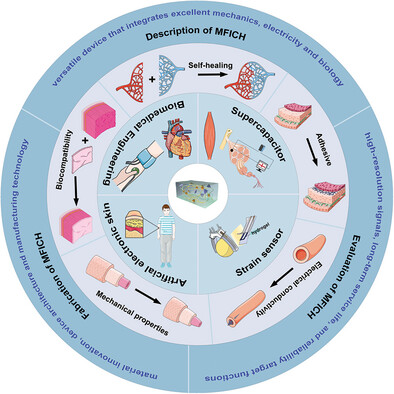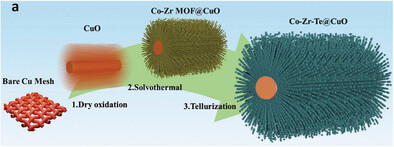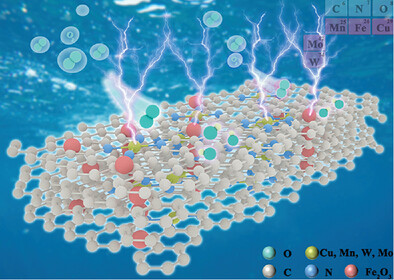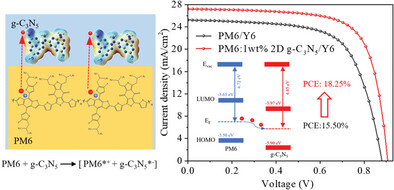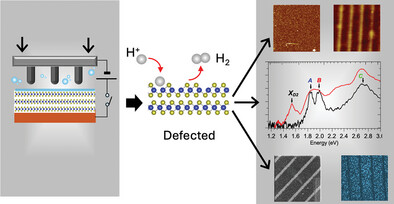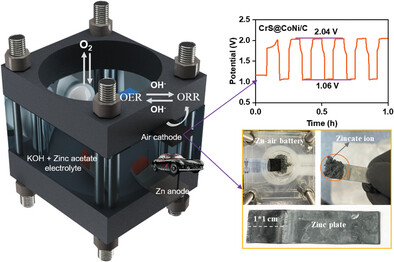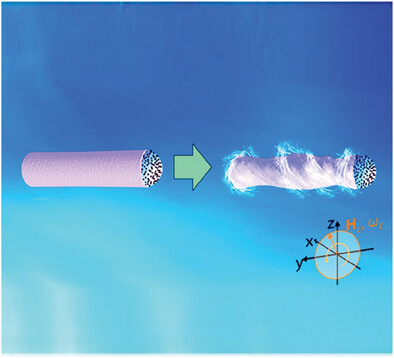Journal list menu
Export Citations
Download PDFs
Cover Picture
Flashlight-induced Ultrafast, Scalable Surface Activation of Highly Loaded Graphite Composite Anode (Small Methods 4/2025)
- First Published: 24 April 2025
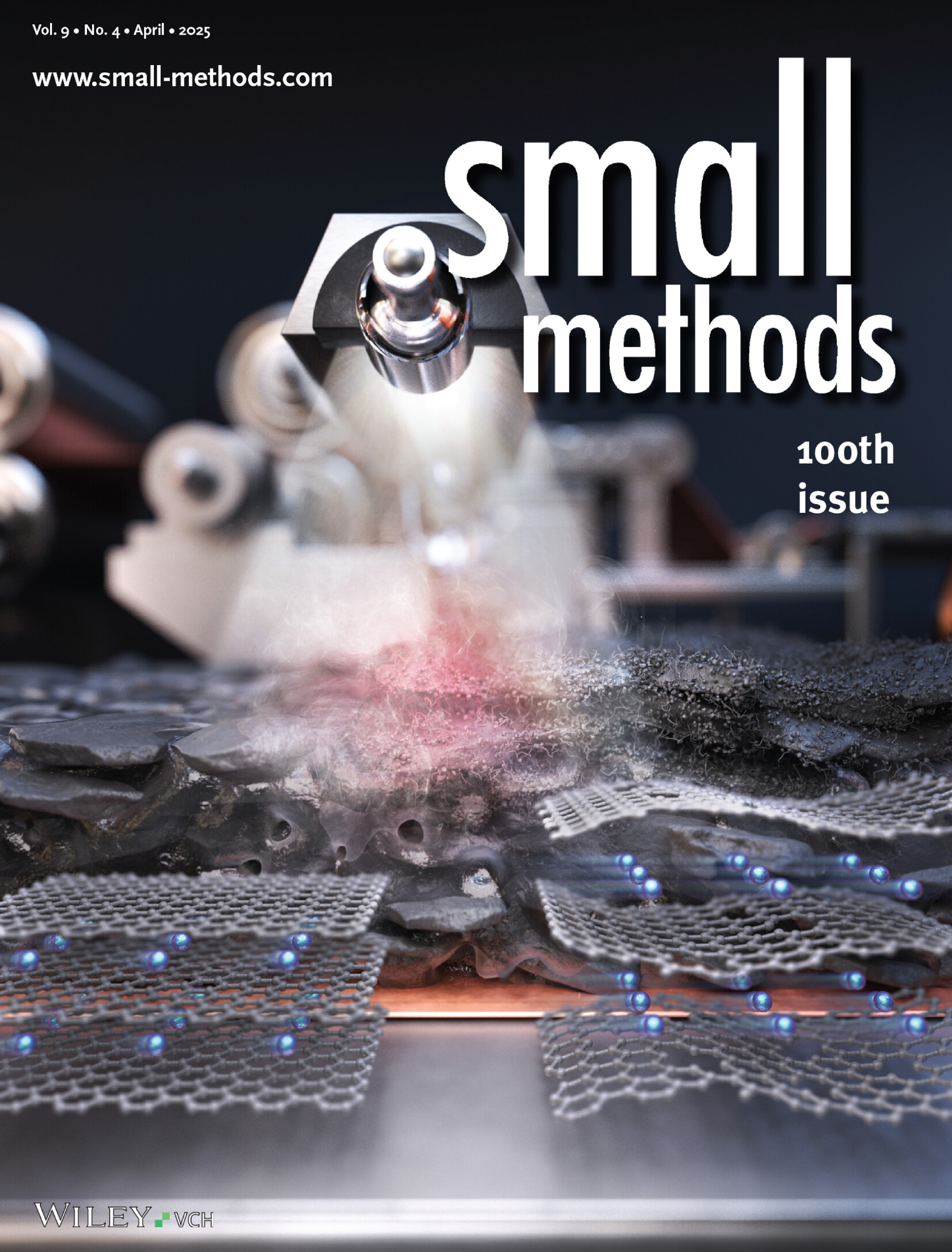
Front Cover
In article number 2401361, Kwon, Woo, and co-workers demonstrated that the electrochemical degradation of highly loaded graphite composite anodes can be improved by a transient flashlight irradiation. This flash-derived surface activation technique is compatible with roll-to-roll, scalable processes, providing a new solution for the fabrication of large-scale, highly loaded electrodes.
Inside Front Cover
Emerging 2D Materials and Van der Waals Heterostructures for Advanced NIR, SWIR, and MWIR Emitters (Small Methods 4/2025)
- First Published: 24 April 2025
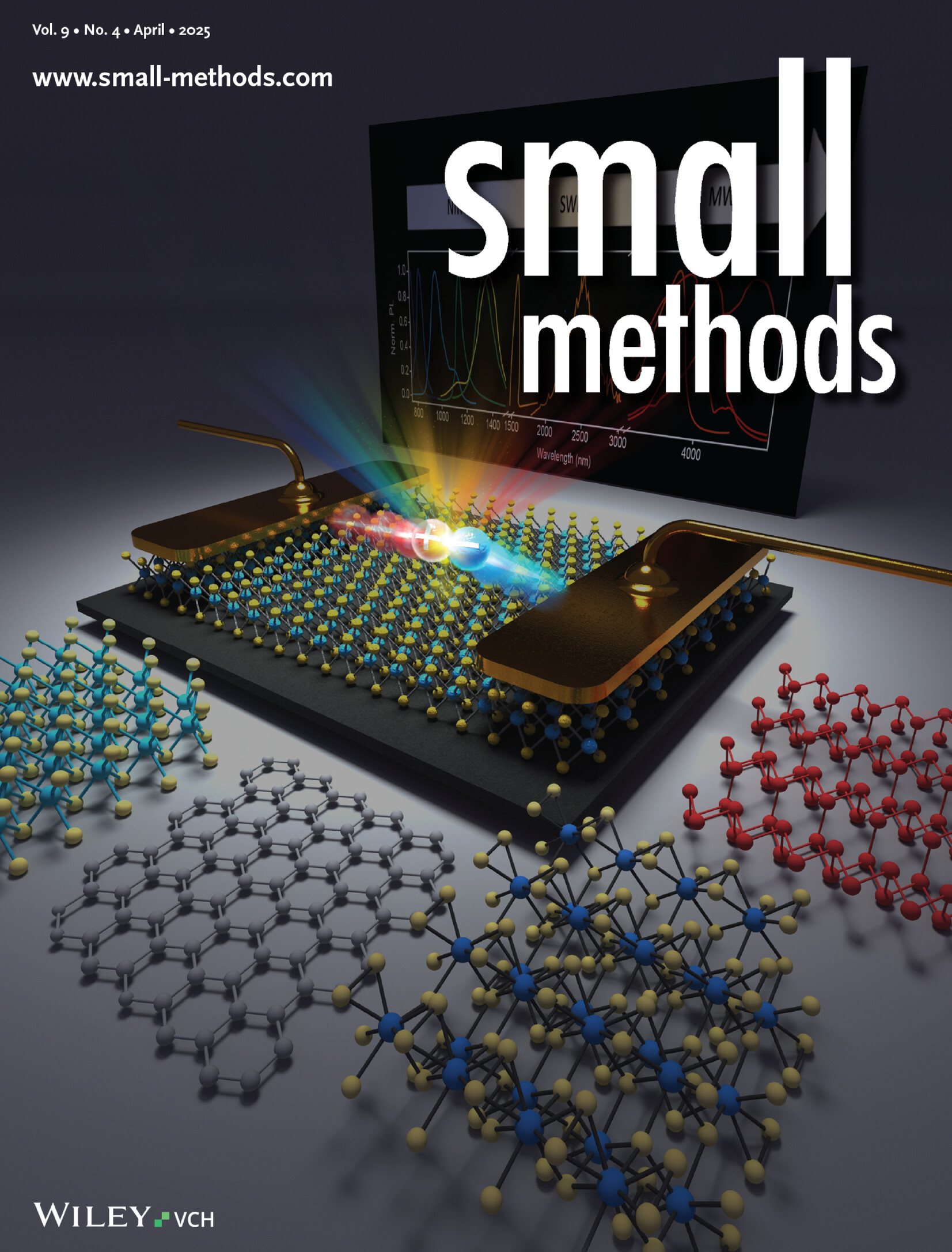
Inside Front Cover
In article number 2401550, Lien, Liu, and co-workers review recent advancements in 2D-based IR emitters across the NIR, SWIR, and MWIR regions. They highlight the unique photoluminescence properties of narrow-gap 2D materials and novel tunable IR emitters enabled by external stimuli, hybridized with nanophotonics, showcasing the transformative potential of 2D materials in IR technologies.
Inside Back Cover
Precision Control of Cell Type-Specific Behavior via RNA Sensing and Editing (Small Methods 4/2025)
- First Published: 24 April 2025
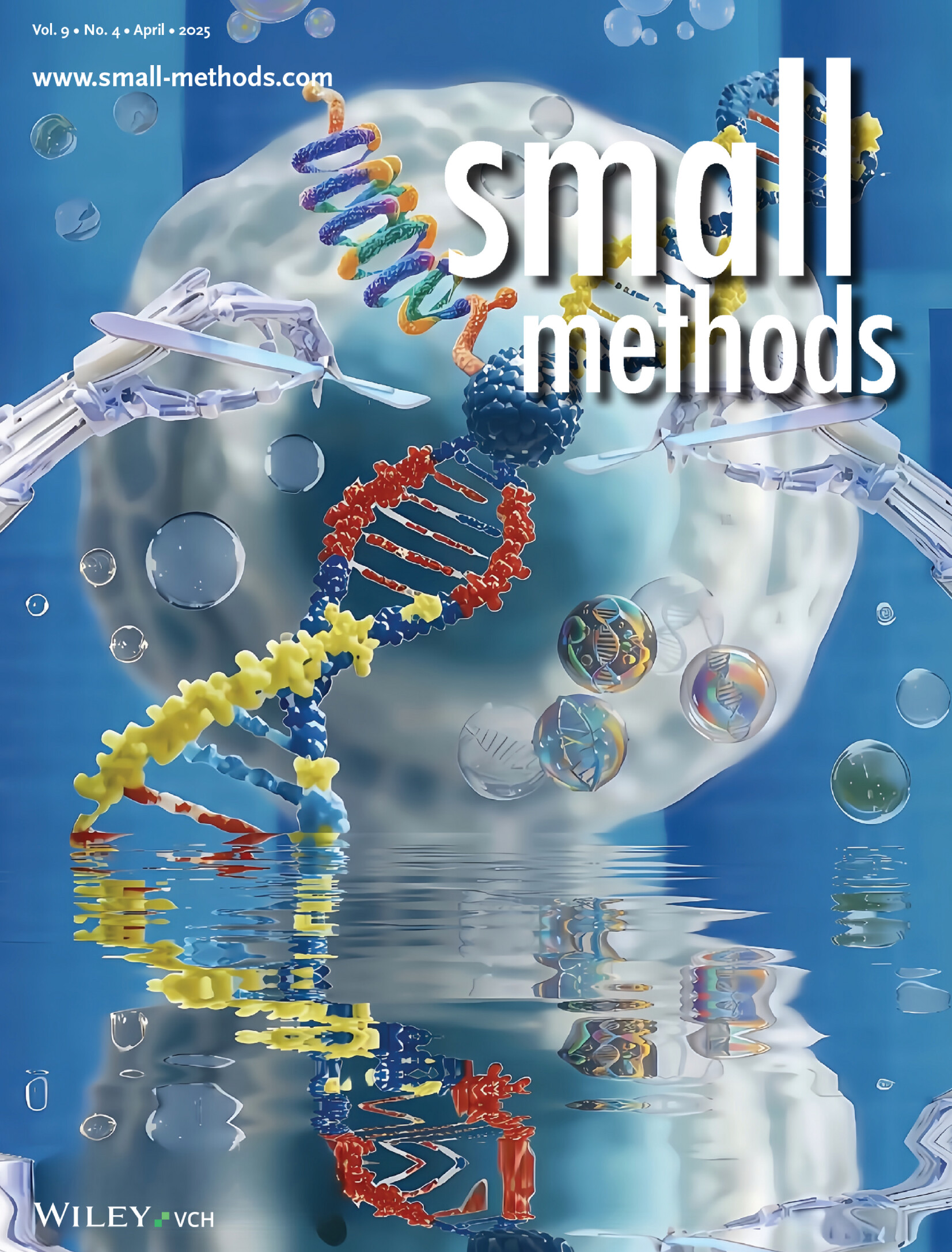
Inside Back Cover
In article number 2400952, Dou, Liu, Duan, and co-workers introduce the innovative CRISPR-ADAReader system, which enables precise manipulation of cell activity through the detection and modification of endogenous RNA. Featuring both positive and negative feedback loops, the system allows for tailored regulation across different cell types in response to various internal signals, showcasing exceptional programmability, specificity, and sensitivity.
Back Cover
Analysis of Metal–Organic Framework and Polyamide Interfaces in Membranes for Water Treatment and Antibacterial Applications (Small Methods 4/2025)
- First Published: 24 April 2025
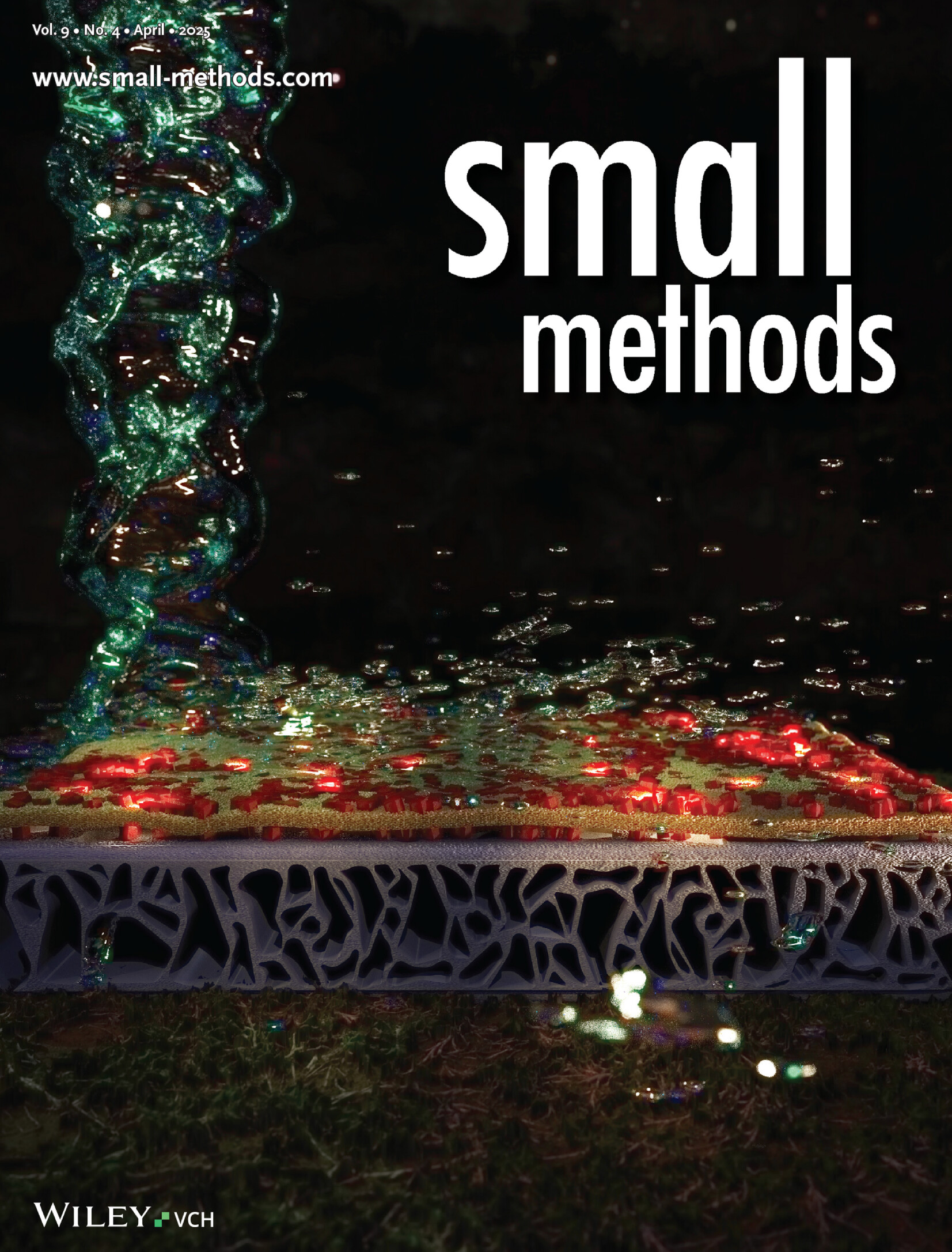
Back Cover
In article number 2401566, Elliott, Firouzjaei, and co-workers explore the integration of silver-based metal-organic frameworks into polyamide membranes using three innovative methods: dip-coating, incorporation, and in situ ultrasonication. The in situ ultrasonicated membranes exhibit enhanced antifouling and biofouling resistance, achieving 94.1% flux recovery. These findings present a promising pathway for advancing water treatment technologies by optimizing membrane performance through nanocomposite engineering.
Issue Information
Review
Emerging 2D Materials and Van der Waals Heterostructures for Advanced NIR, SWIR, and MWIR Emitters
- First Published: 12 December 2024
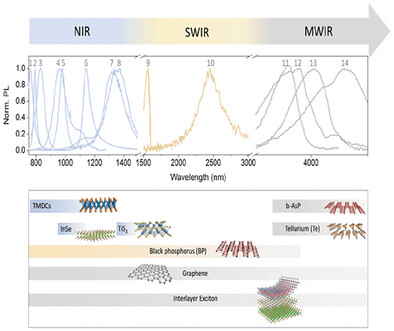
This review highlights recent advancements in 2D-based IR emitters across the NIR, SWIR, and MWIR regions. It explores the photoluminescence properties of 2D materials, vdW engineering techniques for IR LEDs, and the role of external stimuli in tuning emission wavelengths. The review also examines the integration of 2D emitters with photonic structures and discusses the challenges and future prospects of 2D-based IR technologies.
Advances in Electrically Conductive Hydrogels: Performance and Applications
- First Published: 12 November 2024
Microfluidic Synthesis of Magnetic Nanoparticles for Biomedical Applications
- First Published: 06 November 2024
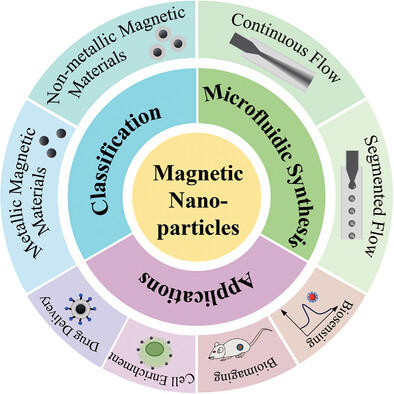
This review summarizes the types of magnetic nanoparticles, microfluidic synthesis, and drug delivery, cell enrichment, bioimaging, and biosensing applications of microfluidic-derived magnetic nanoparticles. In addition, the challenges and prospects in harnessing the full potential of these magnetic nanoparticles are also discussed to highlight the importance of ongoing research in this dynamic field.
Two-Dimensional Transition Metal Dichalcogenides (2D TMDs) Coupled With Zero-Dimensional Nanomaterials (0D NMs) for Advanced Photodetection
- First Published: 15 December 2024
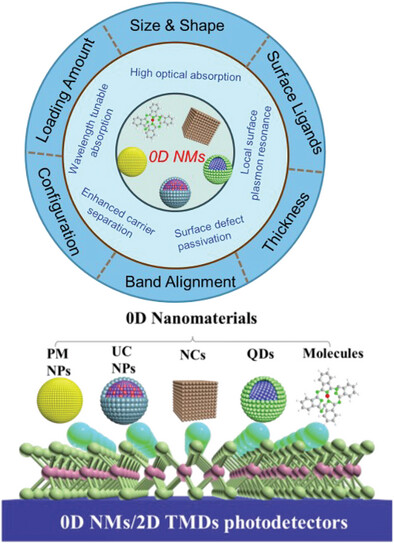
The integration of 2D transition metal dichalcogenides (TMDs) with other materials presents a promising approach to overcome inherent limitations and enable the development of novel functionalities. Herein, the integration of 0D NMs with 2D TMDs to develop high-performance photodetectors is reviewed. The review provides a comprehensive overview of different types of 0D NMs, including plasmonic nanoparticles (NPs), up-conversion NPs, quantum dots (QDs), nanocrystals (NCs), and small molecules.
Flexible Optical Fiber Sensor for Non-Invasive Continuous Monitoring of Human Physiological Signals
- First Published: 02 February 2025
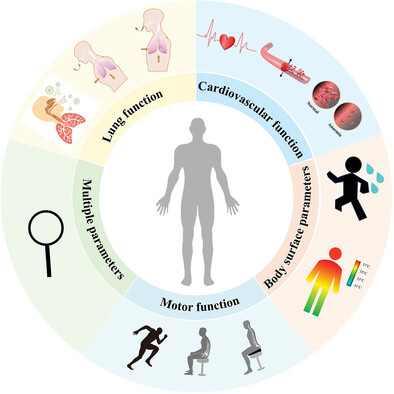
This paper reviews optical fiber sensors (OFSs) for non-invasive monitoring of physiological signals, including lung function, cardiovascular health, and motor function. OFSs offer biocompatibility, anti-electromagnetic interference, and simultaneous signal monitoring. The review highlights the importance of continuous monitoring in health, sports, and emergency settings, discussing challenges and future potential in materials science, sensing, and biomedicine.
Recent Advances in Biosensors Based on Hybridization Chain Reaction and Silver Nanoclusters
- First Published: 05 January 2025

This review explores the integration of hybridization chain reaction (HCR) with silver nanoclusters (AgNCs) to form hybrid HCR-AgNCs biosensors, highlighting advancements in their design, performance, and practical applications. It covers recent innovations, methodological improvements, and the potential of HCR-AgNCs systems as detectors across various fields.
DNA Nanostructures-Based In Situ Cancer Vaccines: Mechanisms and Applications
- First Published: 22 January 2025
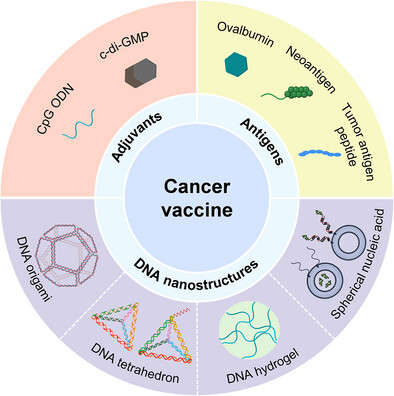
In recent years, DNA nanostructures have attracted widespread attention as drug delivery platforms. It specifically includes DNA as a building block to construct various types of DNA nanostructure, which are subsequently loaded with antigens or adjuvants to perform anti-tumor immunity. This review provides an overview of strategies for utilizing DNA nanostructures for in situ vaccine construction. And the current challenges and future prospects arediscussed and proposed.
Recent Advances in the Design and Application of Asymmetric Carbon-Based Materials
- First Published: 26 January 2025
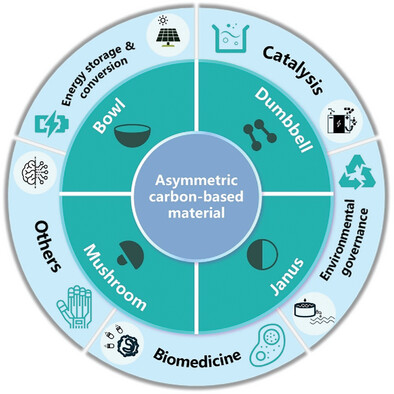
Recent advances in asymmetric carbon-based materials (ACBMs) have shown significant progress in structural properties and multifunctional applications. The synthesis methods of ACBMs and their applications in energy storage, catalysis, and biomedicine, while discussing challenges in production and scalability are summarized here.
Research Article
Analysis of Metal–Organic Framework and Polyamide Interfaces in Membranes for Water Treatment and Antibacterial Applications
- First Published: 21 November 2024
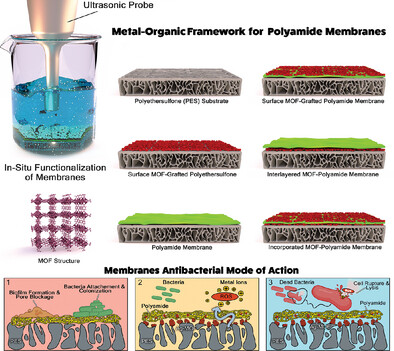
Silver metal–organic frameworks (Ag-MOFs) are synthesized and integrated into polyamide nanofiltration membranes via incorporation, dip-coating, and in situ ultrasonic techniques. Each approach imparts distinct antibacterial, morphological, and surface properties, facilitating tailored design of thin-film nanocomposite membranes for diverse water purification applications.
Flashlight-induced Ultrafast, Scalable Surface Activation of Highly Loaded Graphite Composite Anode
- First Published: 04 December 2024

Various physicochemical changes, including binder carbonization, increased porosity, and enhanced electrolyte permeability could be induced on the surface of highly loaded graphite composite anode using instant flashlight irradiation, leading to a significant improvement of electrochemical performance. This flash-derived surface activation is compatible with a roll-to-roll, scalable process, making it easily adaptable in the battery manufacturing industry.
Frontispiece
Iono-Optic Impedance Spectroscopy (I-OIS): A Model-Less Technique for In Situ Electrochemical Characterization of Mixed Ionic Electronic Conductors (Small Methods 4/2025)
- First Published: 24 April 2025
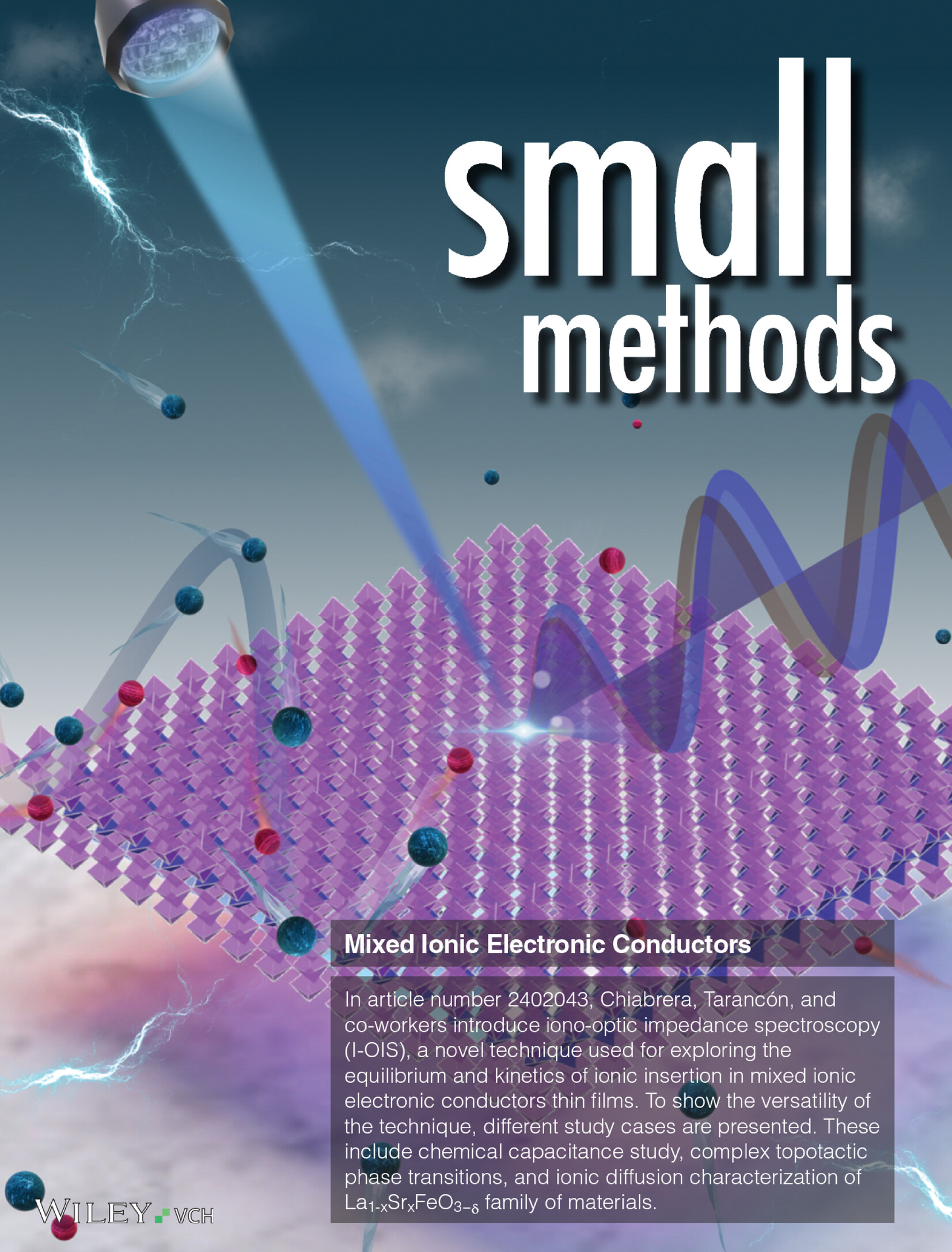
Mixed Ionic Electronic Conductors
In article number 2402043, Chiabrera, Tarancón, and co-workers introduce iono-optic impedance spectroscopy (I-OIS), a novel technique used for exploring the equilibrium and kinetics of ionic insertion in mixed ionic electronic conductors thin films. To show the versatility of the technique, different study cases are presented. These include chemical capacitance study, complex topotactic phase transitions, and ionic diffusion characterization of La1−xSrxFeO3–δ family of materials.
Research Article
Iono-Optic Impedance Spectroscopy (I-OIS): A Model-Less Technique for In Situ Electrochemical Characterization of Mixed Ionic Electronic Conductors
- First Published: 30 December 2024
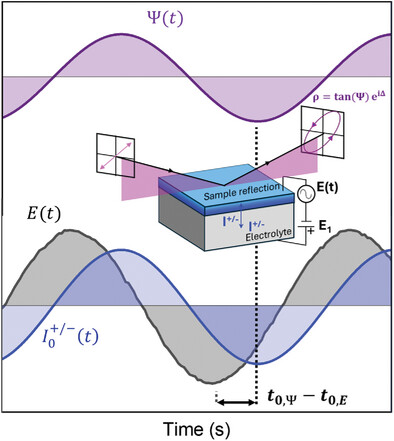
Iono-Optic Impedance Spectroscopy (I-OIS) technique is presented as a model-less technique for ionic defect concentration and (de)insertion kinetics characterization in mixed ionic electronic conductors (MIEC) materials. The results demonstrate the capability of the technique to effectively characterize the underlying electrochemical mechanisms of the response of single- and multi-layered MIEC systems to an external applied potential.
Frontispiece
Rapid High-Throughput Discovery of Molecules With Antimicrobial Activity From Natural Products Enabled by a Nanoliter Matrix SlipChip (Small Methods 4/2025)
- First Published: 24 April 2025
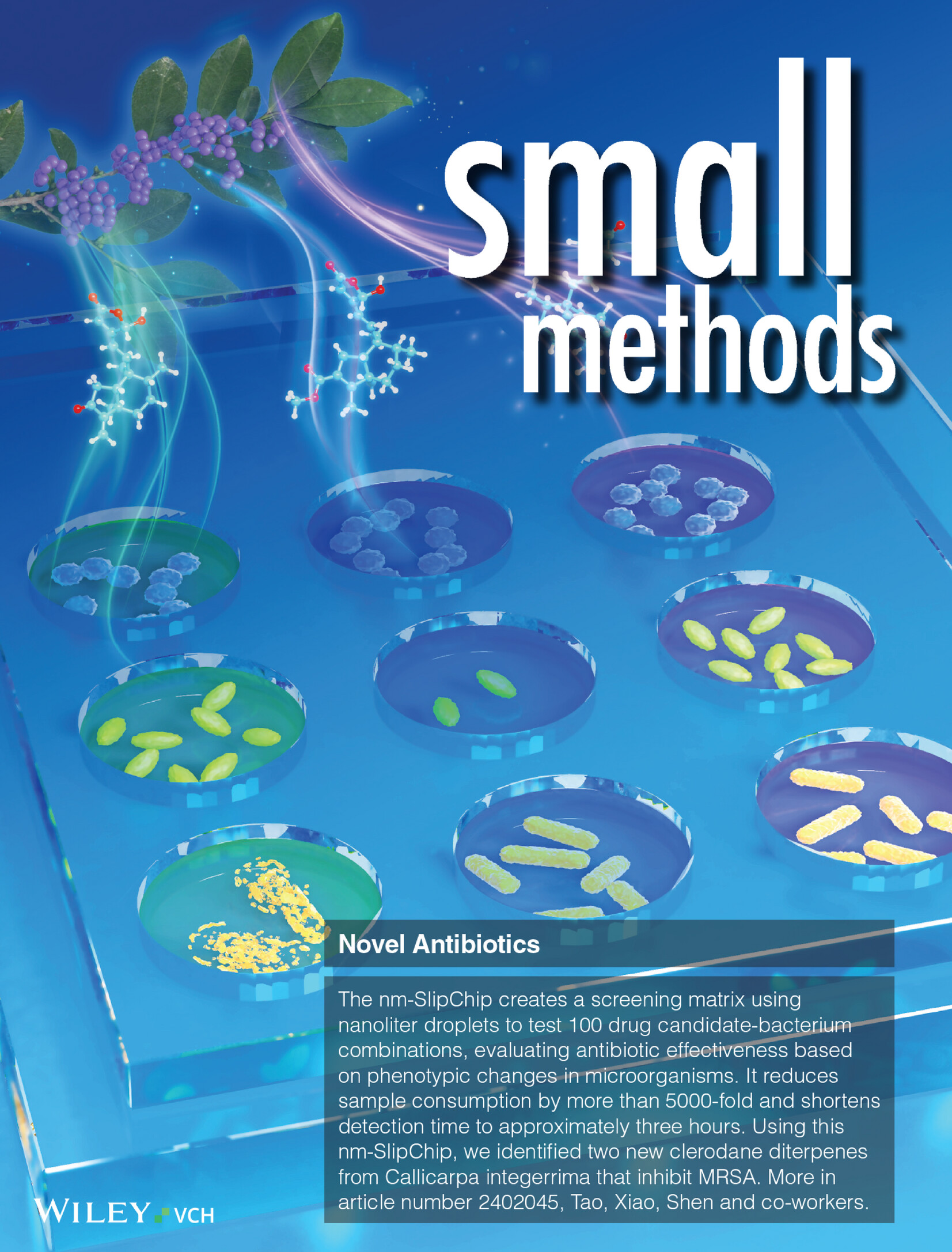
Novel Antibiotics
The nm-SlipChip creates a screening matrix using nanoliter droplets to test 100 drug candidate-bacterium combinations, evaluating antibiotic effectiveness based on phenotypic changes in microorganisms. It reduces sample consumption by more than 5000-fold and shortens detection time to approximately three hours. Using this nm-SlipChip, we identified two new clerodane diterpenes from Callicarpa integerrima that inhibit MRSA. More in article number 2402045, Tao, Xiao, Shen and co-workers.
Research Article
Rapid High-Throughput Discovery of Molecules With Antimicrobial Activity From Natural Products Enabled by a Nanoliter Matrix SlipChip
- First Published: 02 January 2025
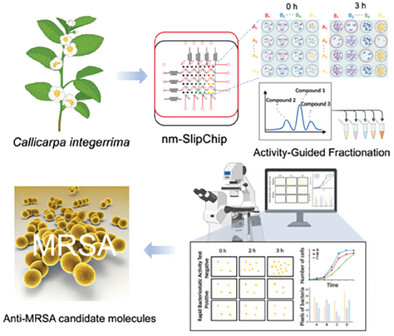
This nm-SlipChip generates a screening matrix with nanoliter droplets for 100 drug candidate-bacterium combinations, assessing antibiotic effectiveness through phenotypic changes in microorganisms. It reduces sample consumption by over 5000-fold and shortens detection time to three hours. Using this nm-SlipChip, two novel clerodane diterpenes active against MRSA is identified from Callicarpa integerrima.
Frontispiece
Facile Design of Highly Stretchable and Conductive Crumpled Graphene/NiS2 Films for Multifunctional Applications (Small Methods 4/2025)
- First Published: 24 April 2025
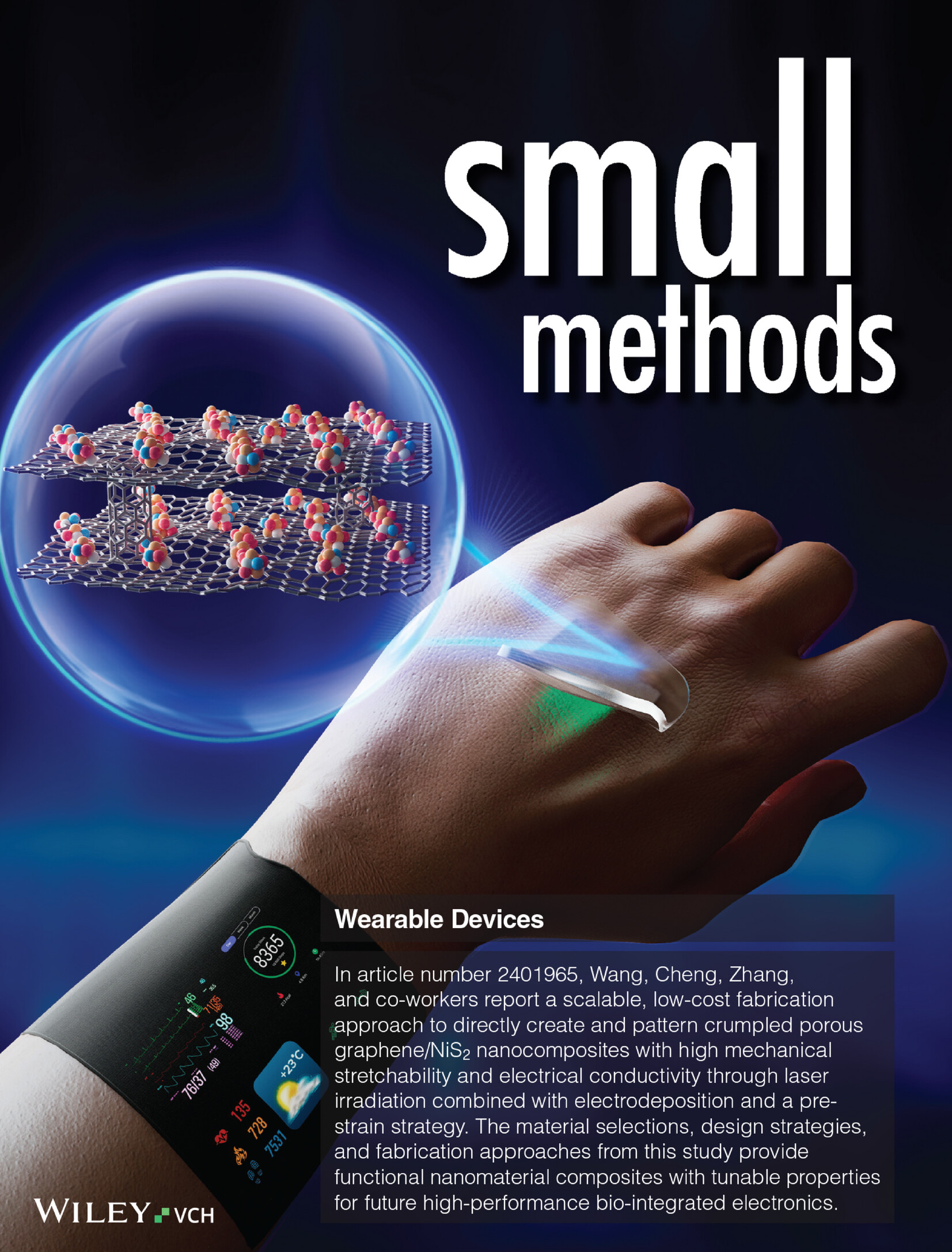
Wearable Devices
In article number 2401965, Wang, Cheng, Zhang, and co-workers report a scalable, low-cost fabrication approach to directly create and pattern crumpled porous graphene/NiS2 nanocomposites with high mechanical stretchability and electrical conductivity through laser irradiation combined with electrodeposition and a pre-strain strategy. The material selections, design strategies, and fabrication approaches from this study provide functional nanomaterial composites with tunable properties for future high-performance bio-integrated electronics.
Research Article
Facile Design of Highly Stretchable and Conductive Crumpled Graphene/NiS2 Films for Multifunctional Applications
- First Published: 09 January 2025
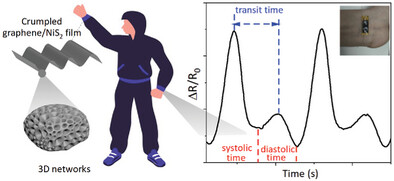
A scalable, low-cost fabrication approach is reported to directly create and pattern crumpled porous graphene/NiS2 nanocomposites with high mechanical stretchability and electrical conductivity through laser irradiation combined with electrodeposition and a pre-strain strategy. This novel synthetic approach holds promise for a variety of bio-integrated electronic applications.
Precision Control of Cell Type-Specific Behavior via RNA Sensing and Editing
- First Published: 05 December 2024

This research presents the innovative CRISPR-ADAReader system, designed to enable precise manipulation of cell activity through RNA sensing. The system incorporates both positive and negative feedback loops, facilitating tailored regulation across various cell types in a single platform. It demonstrates exceptional programmability, specificity, and sensitivity, offering a powerful tool for the customized and precise control of cellular behavior.
Frontispiece
Enabling Charge Trapping with Quasi-Magnetization through Transition Metal Ion-Chelated Mesoporous Silica Particles for Wearable Antibacterial Self-Powering Sensors (Small Methods 4/2025)
- First Published: 24 April 2025
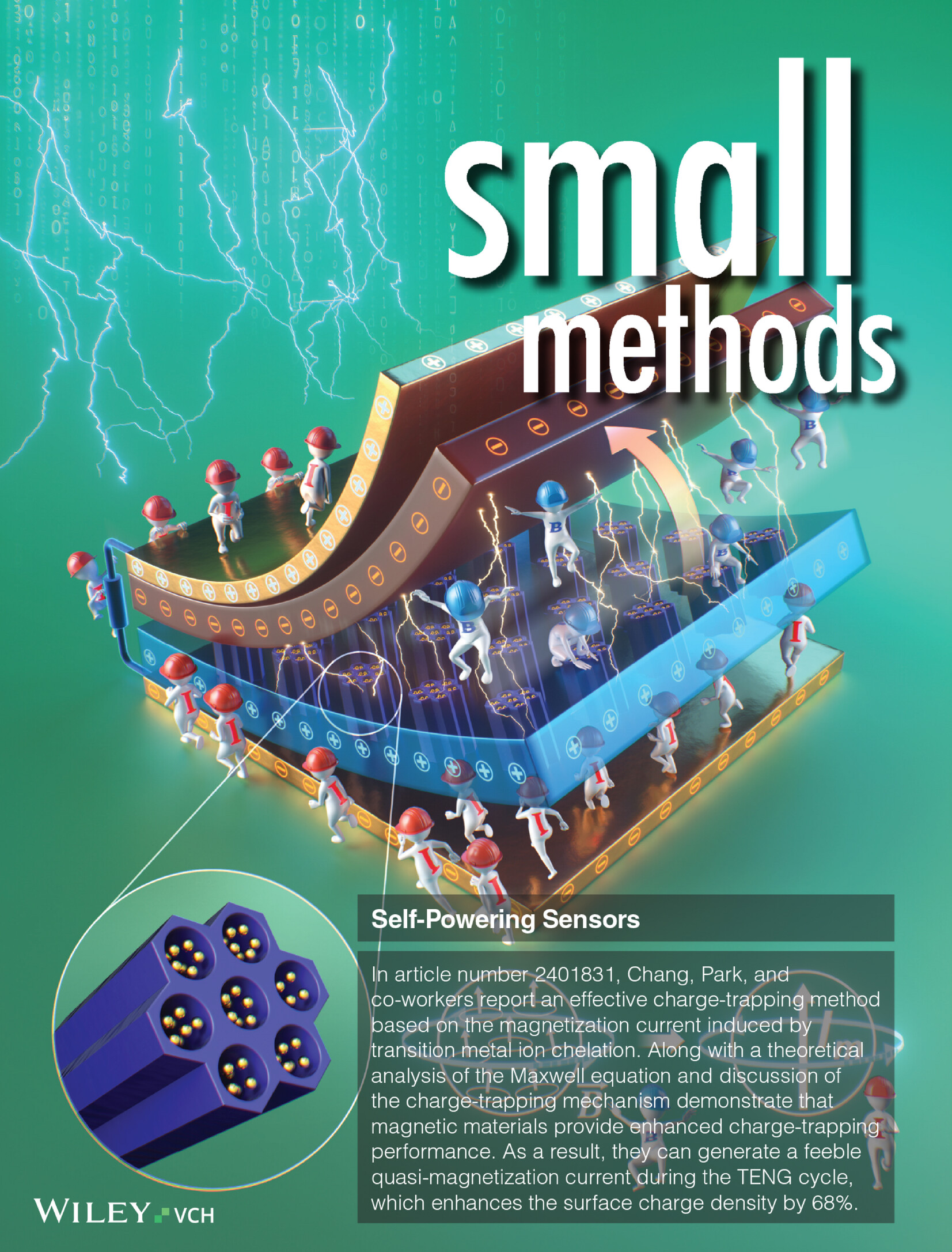
Self-Powering Sensors
In article number 2401831, Chang, Park, and co-workers report an effective charge-trapping method based on the magnetization current induced by transition metal ion chelation. Along with a theoretical analysis of the Maxwell equation and discussion of the charge-trapping mechanism demonstrate that magnetic materials provide enhanced charge-trapping performance. As a result, they can generate a feeble quasi-magnetization current during the TENG cycle, which enhances the surface charge density by 68%.
Research Article
Enabling Charge Trapping with Quasi-Magnetization through Transition Metal Ion-Chelated Mesoporous Silica Particles for Wearable Antibacterial Self-Powering Sensors
- First Published: 13 February 2025
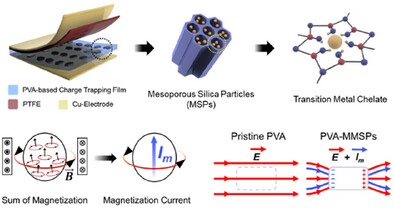
A charge trapping method that utilizes a magnetic field induced from the displacement current generated from triboelectric nanogenerators (TENGs) is demonstrated. For effective charge trapping, transition metal ions are chelated with mesoporous silica, and charge transport and trapping due to the generation of magnetization current improve the surface charge of conventional TENG by 68%.
Advanced Characterization of Perovskite Thin Films for Solar Cell Applications Using Time-Resolved Microwave Photoconductivity and Time-Resolved Photoluminescence
- First Published: 18 March 2025

Here a new methodology combining time-resolved microwave photoconductivity and photoluminescence spectroscopy to measure intrinsic parameters of perovskite samples, namely trap state concentration and carrier mobilities, with high certainty is presented. This faster, more reliable method suggests green solvent systems can achieve comparable performance to traditional solvents despite lower initial efficiencies.
Luminescence-Based Implied Voltage Imaging of Tandem Solar Cells Using Bandpass Filters
- First Published: 01 April 2025
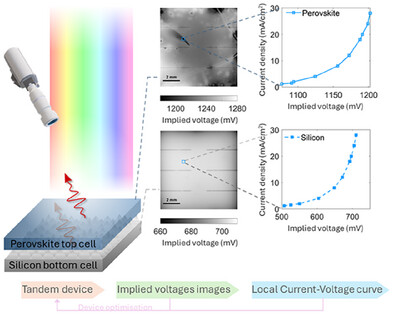
Transitioning high-efficiency tandem cells from lab-scale to commercialization requires reliable characterization. This article presents a luminescence-based technique to spatially quantify individual tandem sub-cell performance. Employing narrow bandpass filters, the technique ensures the luminescence signal is insensitive to the device's optical properties, revealing only open-circuit voltage variations. Fast, non-destructive, and versatile, it facilitates process monitoring and optimizes 2-terminal tandem devices by overcoming conventional I–V limitations.
Epitaxial Thin Film Growth on Recycled SrTiO3 Substrates Toward Sustainable Processing of Complex Oxides
- First Published: 28 October 2024
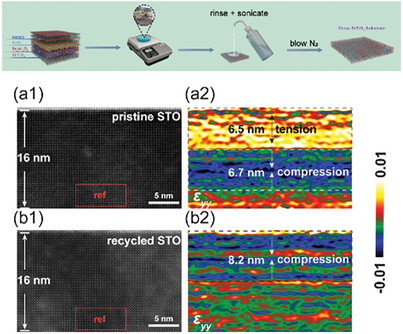
This study investigates the growth of complex oxide thin films on recycled SrTiO3 (STO) substrates, revealing modified properties due to distinct surface strain states after recycling compared to pristine substrates. The research underscores the importance of careful substrate management for sustainable processing through recycled substrate.
Intercalation of Al3+ into Prussian Blue Analogues from Nonaqueous Electrolytes
- First Published: 30 August 2024
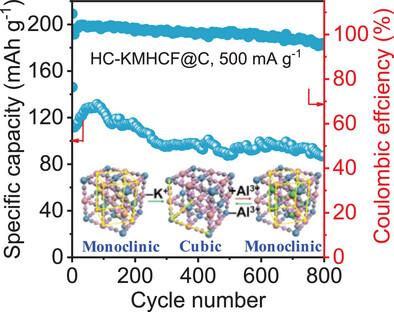
Carbon combined highly crystalline KMHCF (HC-KMHCF@C) is synthesized through a chelator-assisted preparation method in combination with an in situ carbon compositing technique. The HC-KMnHCF@C demonstrates excellent cycling performance in nonaqueous Al-ion batteries. Mechanistic studies indicate that HC-KMnHCF@C undergoes reversible phase transitions during Al-ion intercalation and deintercalation, with Mn and Fe elements serving as charge compensators.
Caesium-Iodide-Assisted Synthesis of High-Quality, Stable, and Robust Lead-Free Perovskite Quantum Dots
- First Published: 07 November 2024

This study presents a straightforward method for synthesizing high-quality CsSnI3-based perovskite quantum dots (TQDs) using a mixed cesium source of Cs2CO3 and CsI. The inclusion of CsI enhances the iodine-to-tin ratio, leading to smaller, more uniform TQDs with improved crystallinity, photoluminescence, and antioxidation properties. These TQDs exhibit remarkable air stability and maintain robustness following ligand exchange, underscoring the critical role of CsI in TQD growth and surface complex formation.
Precursor-Driven Confined Synthesis of Highly Pure 5-Armchair Graphene Nanoribbons
- First Published: 02 November 2024
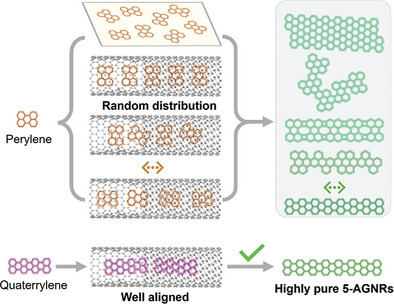
A novel synthesis route of achieving 5-armchair graphene nanoribbons with high purity and long length via confined polymerization of non-halogen precursors inside single-walled carbon nanotubes is proposed, breaking the strong dependence on metal substrates and halogen-containing precursors in current on-surface synthesis of such graphene nanoribbons with a quasi-metallic gap promising in electronics and optoelectronics.
Improving the Cycling Stability of NCM811 at High-Voltage 4.5V in Ester-Based Electrolytes with LiDFOB
- First Published: 04 December 2024
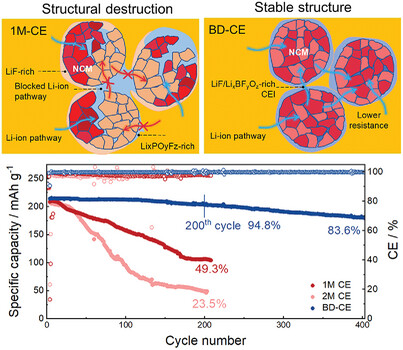
LiDFOB enhances cycling stability of nickel-rich NCM811 cathodes at 4.5 V by forming a protective interface and reducing structural degradation caused by anisotropic lattice changes. NCM811|Li cells with LiDFOB achieve 214 mAh g−1 and 83.6% capacity retention after 400 cycles at 1 C, improving NCM811's performance for high-energy applications.
Platinum Nanozyme-Loaded Dissolving Microneedles Scavenge ROS and Promote Lineage Progression for Androgenetic Alopecia Treatment
- First Published: 18 October 2024
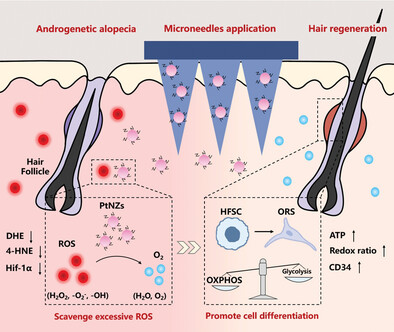
Androgenetic alopecia (AGA) presents a significant challenge with limited treatments. The dissolving microneedles loaded with platinum nanozymes (Pt-MNs) are designed to overcome the skin barrier and induce hair regeneration. The mechanicians include reducing oxidative stress and promoting follicle stem cell differentiation. The Pt-MNs group achieves faster hair growth than minoxidil, with high safety confirmed.
Soft Colloidal Electrode Enabled by Water Distribution Control for Ultra-Stable Aqueous Zn–I Batteries
- First Published: 12 November 2024
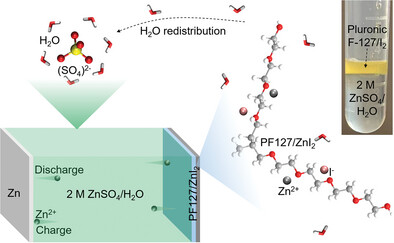
An aqueous Zn||Pluronic F127 (PF127)/ZnI2 colloid battery is presented that leverages the water molecular regulation effect of ZnSO4. Specifically, ZnSO4 functions as a water molecular valve, controlling the water content within the water-soluble PF127 polymer to form a stable colloid. This design enables the aqueous battery to achieve an ultra-stable cycling lifetime.
Organic Dye Molecule Intercalated Prussian Blue for Simultaneously Enhancing Coloration Efficiency and Energy Storage Capacity in Electrochromic Battery
- First Published: 14 October 2024
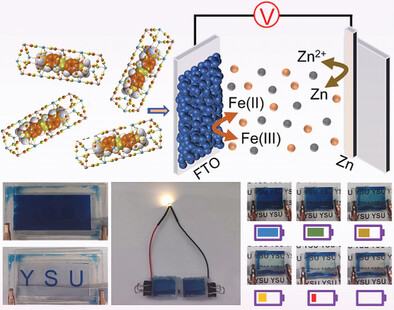
An electrochromic battery with methyl orange inserted into a Prussian blue channel as the active layer is assembled, exhibiting high optical contrast (81.4% at 670 nm), high coloration efficiency (265 cm2 C−1), and excellent specific capacity (84 mAh m−2 at 0.05 A m−2), greatly superior to those of pure PB films, due to the adjustments in the electronic structure of the Prussian blue framework.
High-Power and Long-Lifespan Rechargeable Ion Batteries based on Na+-Confined Na+/Mg2+ Coinsertion Chemistry
- First Published: 31 October 2024
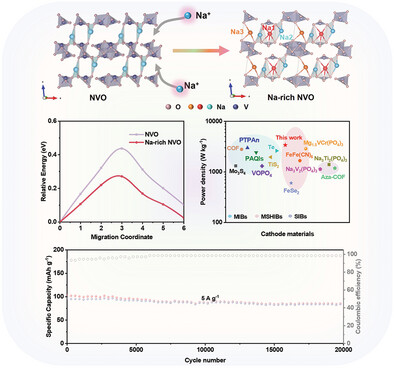
The excess interlayer Na+ in the Na3.7V6O16•2.9H2O (Na-rich NVO) cathode confines the ionic diffusion pathway to a specific direction, enhances the electronic conductivity, and pins the structure for higher stability. The coinsertion/extraction of Mg2+ and Na+ improves the power density and lifespan of MSHIBs.
Protein Electronic Energy Transport Levels Derived from High-Sensitivity Near-UV and Constant Final State Yield Photoemission Spectroscopy
- First Published: 10 December 2024
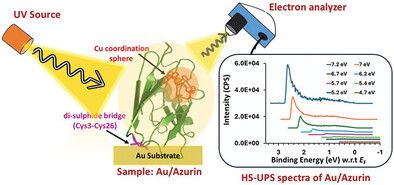
Here high-sensitivity soft UV photoemission spectroscopy (HS-UPS) combined with Constant Final State Yield Spectroscopy (CFS-YS) is used to get the information on the energetics of electrode/protein contacts. It is found that combined HS-UPS/CFS-YS measurements agree with the Photoelectron Yield Spectroscopy (PYS), and show potential as a powerful tool to characterize and map the energetics of a protein-electrode interfaces.
Mitigating Capacity and Voltage Decay in Li-Rich Cathode Via Dual-Phase Design
- First Published: 29 September 2024
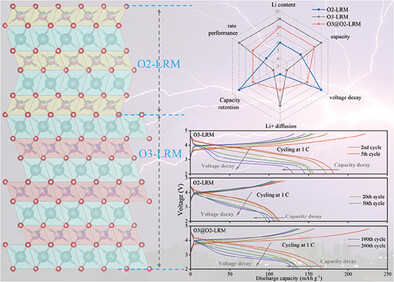
A novel composite material is synthesized by coating the surface of O3 phase Li-rich Mn-based oxides with its isoform, the O2 phase. This composite combines the best attributes of both O3 and O2 phases, inheriting the high-capacity advantage of the O3 phase while exhibiting the reduced voltage decay of the O2 phase.
Observation of a Novel Interligand Chiral Arrangement in Metal Nanoclusters and Its Implication in Resisting Racemization
- First Published: 09 September 2024

A chiral nanocluster R/S-Au24Cd2 is synthesized with a new chiral (+/−)-fenchyl thiol ligand. Through crystal structure analysis, it is found that its chirality comes from five-hierarchy chiral structure assembly. Because of the hierarchical chirality, it has superb chirality stability and the ability to resist racemization.
Unlocking Single-Particle Multiparametric Sensing: Decoupling Temperature and Viscosity Readouts through Upconverting Polarized Spectroscopy
- First Published: 03 November 2024
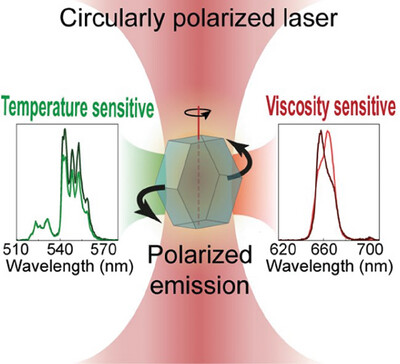
Upconverting particles (UCPs) are valuable imaging probes due to their ability to convert infrared to visible light and respond to various stimuli. However, crosstalk among stimuli limits their multiparametric sensing utility. This study introduces a NaYF4:Er3+, Yb3+ UCP that enables simultaneous, reliable temperature, and viscosity readings by separating thermal and mechanical measurements, offering promising advancements in sensing applications.
Surface Reconstruction Enhanced Li-Rich Cathode Materials for Durable Lithium-Ion Batteries
- First Published: 18 September 2024

This study modifies lithium-rich cathodes by enriching Ni and Co on the surface while reducing Mn, preventing irreversible phase transitions, and enhancing stability. The molten salt treatment leads to a stable (001) crystal orientation, as shown in the TOC graphic. The treated material achieved 189.8 mAh g−¹ after 500 cycles at 1 C, with an 88.9% retention rate. These findings demonstrate the potential of this approach for improving lithium-rich cathode performance and commercial viability.
In Situ Optical Observation of Lithium Dendrite Pattern in Solid Polymer Electrolytes
- First Published: 03 November 2024
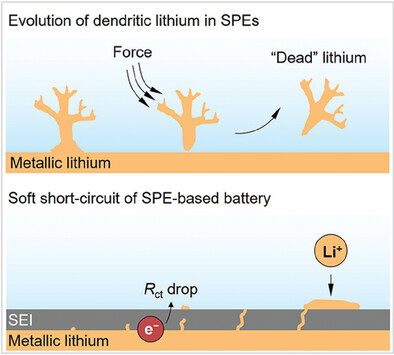
Unlocking lithium dendrite patterns in solid polymer electrolytes (SPEs) is of particular importance for exploiting highly performing solid-state lithium batteries. The current work demonstrates that the dendrite growth in SPEs is memoryless, and the soft short-circuit behavior observed in SPE-based cells could be related to the increased electronic conductivities brought by the exposure of fresh lithium metal.
Impact Deposition of a Single Droplet of Low-Melting-Point Alloy as the Top Electrode for Organic Photovoltaics
- First Published: 03 October 2024
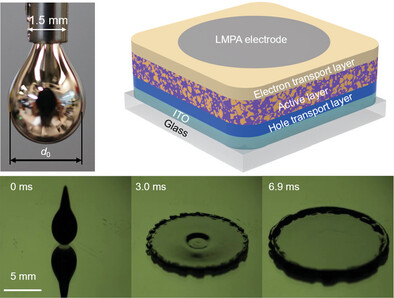
Low-melting-point-alloy (LMPA) electrodes are directly deposited on OPVs by falling a single LMPA droplet onto the substrate. The droplet spreads to form a thin film intimately contacting the substrate. The electrode area is tailored by adjusting the droplet diameter or the Weber number. The interface morphology is mainly affected by the contact temperature. LMPA-OPVs exhibit power conversion efficiencies of 16.17%.
A Relationship Between Semiconducting Thin Film's Electronic Structure Heterogeneity and Defect Tolerance
- First Published: 10 December 2024

By examining the ratio of the bulk density of states to the surface density of states as a function of the loss tangent using the energy-resolved electrochemical impedance spectroscopy, valuable insight can be gained into whether the defect states within the bandgap of the semiconducting thin film meet the essential criteria for defect-tolerant materials.
Accelerated Exosomal Metabolic Profiling Enabled by Robust On-Target Array Sintering with Metal–Organic Frameworks
- First Published: 12 September 2024
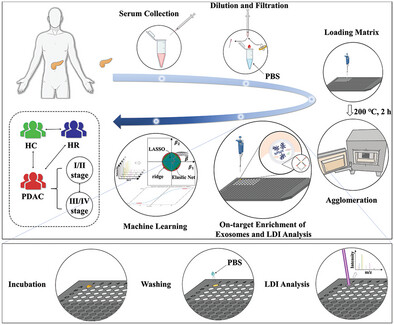
An on-target sintering matrix-based platform facilitates efficient in situ enrichment of exosomes on target and direct LDI detection. The metabolic profiles of exosomes extracted based on this platform are combined with machine learning to enable the simultaneous early diagnosis of pancreatic cancer, screening of high-risk groups, and staging of pancreatic cancer.
Fe-Mediated Tweaking of Band Bending and Activation Energy in α-MoO3 Nano Lamella for Enhanced NO2 Gas Detection Under Low Operating Temperature
- First Published: 23 September 2024
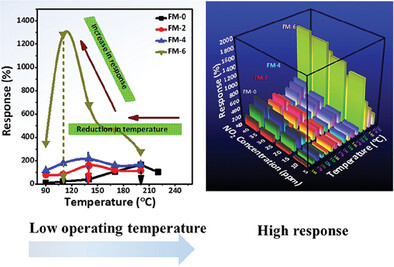
Randomly ordered nano ribbons of α-MoO3 with large surface sites for gas interaction enabled via Fe incorporation. An excellent response of 1282% for 10 ppm of NO2 at a low working temperature of 110 °C is the important outcome of this report. In addition, Ultra-low limit of detection of 79 ppt and long-term stability added an advantage.
Scalable Slot-Die Coating of Passivation Layers for Improved Performance of Perovskite Solar Cell Modules
- First Published: 20 November 2024
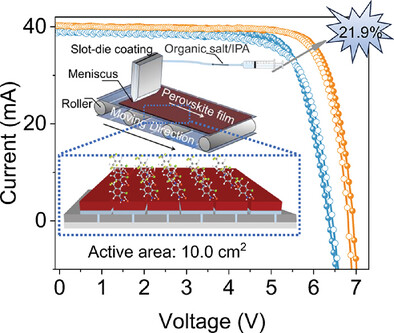
This work describes a scalable slot-die coating technique for the fabrication of uniform and reproducible surface passivation layers, which exhibits compatibility with various passivating agents, particularly organic ammonium salts. A champion efficiency of 21.9% with improved stability is achieved for 2-chloro-5-(trifluoromethyl)-phenylammonium bromide (CF3-Cl-PhABr) coated perovskite solar modules with an active area of 10 cm2.
Additive-Free Sequential Thermal Evaporation of Near-Intrinsic Pb-Sn Perovskites
- First Published: 06 December 2024
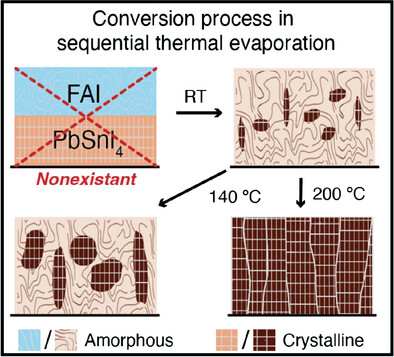
Low bandgap materials are imperative for high-efficiency tandem solar cells. This work uses sequential thermal evaporation in vacuum to produce lead-tin perovskites, yielding crystalline and compact films. The effects of different annealing temperatures and the incorporation of Cs+ into the A-site are explored. Also, the films are compared to spin-coated samples to demonstrate their near-intrinsic nature without using any additives.
Twinned Metal–Organic Framework Nanoplates for Hydrocarbon Separation Membranes
- First Published: 09 November 2024
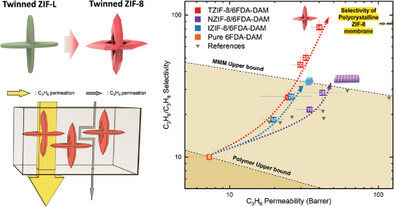
This study proposes twinned zeolitic imidazolate framework-8 (TZIF-8) nanoplates to improve gas separation in mixed matrix membranes (MMMs). The ZIF-L shape is controlled and successfully converted it into TZIF-8. By integrating TZIF-8 into 6FDA-DAM polymer, the enhanced propylene/propane selectivity, similar to polycrystalline ZIF-8 membranes are achieved. This approach creates efficient gas channels and tortuous pathways, surpassing traditional MMMs in separation performance.
Nucleus-Spike 3D Hierarchical Superstructures via a Lecithin-Mediated Biomineralization Approach
- First Published: 07 October 2024
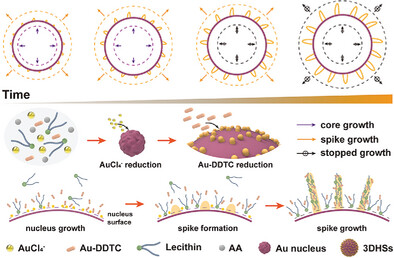
3D hierarchical superstructures (3DHSs) are key products of nature's evolution and have raised wide interest. However, the preparation of 3DHSs composed of building blocks with different structures is rarely reported, and regulating their structural parameters is challenging. Herein, For the first time, a simple lecithin-mediated biomineralization approach is reported to prepare gold 3DHSs composed of 0D nucleus and 1D protruding dendritic spikes.
A Dual Effect Additive Modified Electrolyte Strategy to Improve the Electrochemical Performance of Zinc-Based Prussian Blue Analogs Energy Storage Device
- First Published: 02 November 2024
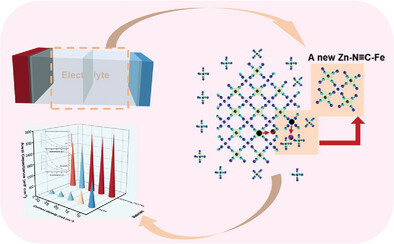
Prussian blue analogs (PBA) are a class of good electrode materials for energy storage devices, but the presence of transition metal ions dissolving in water leads to performance degradation. This paper proposes a dual effect additive-modified electrolyte method. Through experiments and molecular simulation calculations, it demonstrates the construction of a stable and efficient PBA energy storage materials application system.
Highly Active NiRu/C Cathode Catalyst Synthesized by Displacement Reaction for Anion Exchange Membrane Water Electrolysis
- First Published: 12 November 2024

NiRu/C electrocatalyst for hydrogen evolution reaction in alkaline media is synthesized by a galvanic displacement method. Using this method, small clusters of Ru are homogeneously deposited on carbon support particles, resulting in superior Ru catalyst utilization. In anion exchange membrane electrolysis testing with a low overall PGM loading of 0.05 mg cm−2, the NiRu/C catalyst notably outperforms state-of-the-art Pt/C.
Zincophile Zn2+ Conductor Regulation by Ultrathin Nano MoO3 Coating for Dendrite-Free Zn Anode
- First Published: 13 September 2024

In this paper, a new zinc anode MoO3@Zn with an ultrathin layered MoO₃ coating is prepared by a one-step vacuum evaporation method, effectively solving the problems of dendrite growth, hydrogen evolution, and corrosion on the negative electrode side. In addition, the MoO₃ coating provides a deintercalation channel for Zn2+ and regulates its uniform deposition at the zinc anode interface.
Expanding the Potential Window through Synergistic Design and Oriented Heterostructure for Supercapacitor
- First Published: 19 September 2024
Molten Salt-Assisted Synthesis of Ferric Oxide/M–N–C Nanosheet Electrocatalysts for Efficient Oxygen Reduction Reaction
- First Published: 08 October 2024
Room-Temperature Single-Phase Synthesis of Semiconducting Metal-Covalent Organic Frameworks With Microenvironment-Tuned Photocatalytic Efficiency
- First Published: 11 October 2024
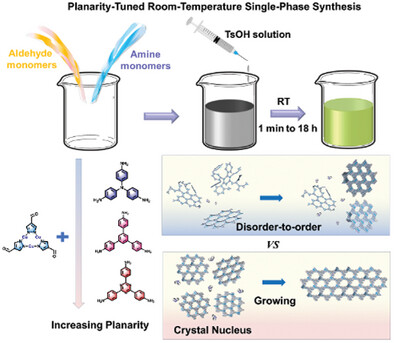
A room-temperature single-phase synthetic strategy for rapidly preparing planarity is reported and microenvironment-tunable semiconducting MCOFs based on the Schiff base reaction between C3v monomers with different geometric configurations and metalated monomers. It can be observed that there is a planarity-tuned and competitive growth relationship between disordered structures and crystal nucleus for the first time.
Van der Waals Epitaxy of High-Quality Transition Metal Dichalcogenides on Single-Crystal Hexagonal Boron Nitride
- First Published: 18 October 2024
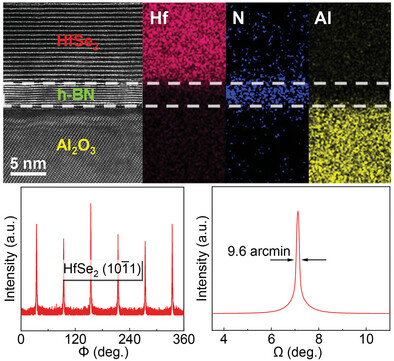
Several high-quality single-crystalline transition metal dichalcogenides are directly grown on an epitaxial h-BN/sapphire substrate via vdW epitaxy, indicating the h-BN is an ideal template for vdW epitaxy. The full width at half maximum of the X-ray diffraction rocking curve for the HfSe2 layers on single-crystal h-BN is only 9.6 arcmin, indicating an extremely high degree of out-plane orientation and high crystallinity.
Self-Assembly Hybrid Manufacture of Nanoarrays for Metasurfaces
- First Published: 23 October 2024
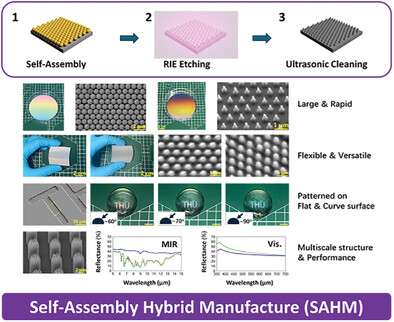
The Self-Assembly Hybrid Manufactur (SAHM) method has been innovated to enhance the rapid, large-scale production of nanoarray-based metasurfaces, accommodating fabrication on flexible substrates. By synergizing with traditional techniques, SAHM can fabricate nanoarrays on both planar and curved surfaces, while also allowing for the fabrication of prefabricated structures to create multiscale assemblies that manipulate electromagnetic waves across various wavelengths.
Redox State-Driven Synthesis of Mesoporous and Microsphere Poly(phenylenediamine) for Transition Metal-Free and All-polymer Dual-Ion Battery
- First Published: 15 December 2024
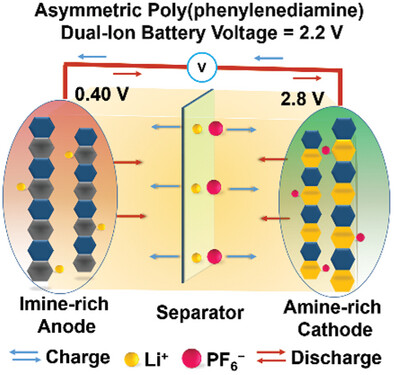
Phenylenediamine, a simple molecule, is engineered to synthesize both cathode and anode materials. It is transformed into amine-rich and imine-rich polymers, enabling oxidative and reductive states. The asymmetric dual-ion battery utilizes polarity differences with an amine-rich cathode and an imine-rich anode, driven by aromatic and quinoid resonance stabilization of radical ions at respective electrodes.
Biomimetic Multi-Interface Design of Raspberry-like Absorbent: Gd-doped FeNi3@Covalent Organic Framework Derivatives for Efficient Electromagnetic Attenuation
- First Published: 03 October 2024
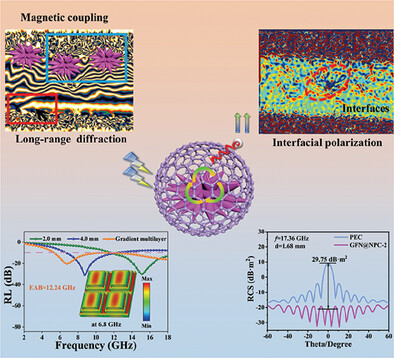
The study employs a novel monomer-mediated strategy to control the growth of electromagnetically functionalized GFN@NPC. Off-axis electron holography reveals that the synergistic effect of ferromagnetic coupling and long-range magnetic diffraction between Gd and FeNi3 enhance both saturation magnetization and permeability, further optimizing magnetic loss and impedance matching. Moreover, metamaterial design and far-field electromagnetic response lay a strong foundation for practical applications.
Direct Tensile Testing of Free-Standing Ultrathin Polymer Films on Liquid Surface at High Temperature
- First Published: 19 December 2024

A direct tensile testing system for free-standing ultrathin polymer films uses a heated liquid platform to enable measurement of tensile properties of the ultrathin films without substrate effects. This methodology accurately reveals intrinsic tensile properties with temperature and thickness, highlighting importance of understanding thermo-mechanical properties of 2D materials for advanced electronic devices.
Silver Nanocube Epitaxy via Nanogap-Induced Electrostatics
- First Published: 25 February 2025
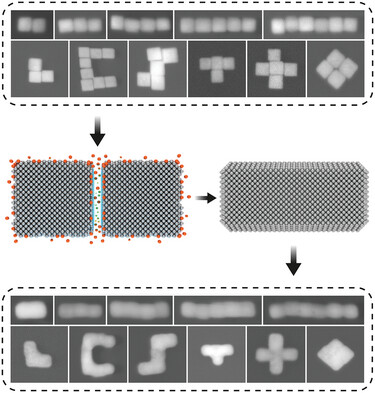
A reductant-free liquid-phase method enables the epitaxial welding of monocrystalline silver nanocubes. By controlling parameters such as temperature, pH, and capping agent, intricate silver nanostructures can be precisely crafted from assembled nanocubes. This innovation paves the way for scalable, bottom-up fabrication of high-quality optical metasurfaces, seamlessly integrated into nanophotonic devices.
2D g-C3N5 p-Doping of Donor Material for High-Efficiency Organic Solar Cells
- First Published: 14 October 2024
Robust Plasma-Assisted Growth of 2D Janus Transition Metal Dichalcogenides and Their Enhanced Photoluminescent Properties
- First Published: 27 October 2024
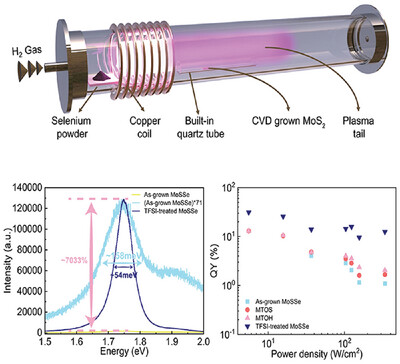
A robust plasma-assisted (RPA) synthesis strategy is introduced with a specially designed tube for a uniform plasma atmosphere. This enables broader growth parameter variations while preserving Janus MoSSe's morphology. Enhancements in photoluminescence (PL) are achieved through bis(trifluoromethane) sulfonimide (TFSI) treatment, resulting in a 70-fold PL intensity increase and a quantum yield (QY) of 31.2%.
Visible-Light Photo-Iniferter Polymerization of Molecularly Imprinted Polymers for Direct Integration with Nanotransducers
- First Published: 24 January 2025
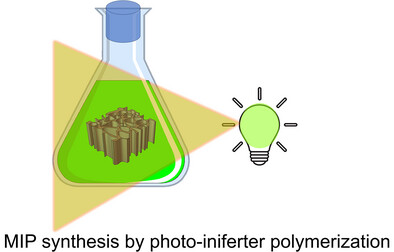
This study overcomes the challenges of integrating MIPs with nanostructured transducers for chemical sensing. It demonstrates precise MIP deposition on nanoporous silica (PSiO2) via controlled radical photopolymerization, achieving uniform thin films. Using propranolol as the template, the resulting MIP-based PSiO2 optical sensor offers high sensitivity, selectivity, and stability, with successful application in real matrices like tap water and a 60-day lifespan.
Decrypting Synergy of Alloy & Metal Nanoparticles Within Nitrogen-Doped Carbon Nanosheets for Zn-Air Batteries with Ultralong Cycling Stability
- First Published: 23 October 2024

A 1D coordination polymer derived FeNi and Co nanoparticles co-embedded N-doped carbon nanosheets (denoted FNC/NCS) is judiciously crafted, delivering prominent ORR/OER activity owing to the synergy between FeNi alloy and Co NPs. The FNC/NCS-assembled Zn-air batteries possess high specific capacity, and power density, as well as ultra-long cycling life in aqueous (> 3300 h) and solid-state (> 150 h) electrolytes.
Enhanced Buried Interface Engineering for Efficient Inverted Perovskite Solar Cells Fabricated via Vapor–Solid Reaction
- First Published: 16 September 2024
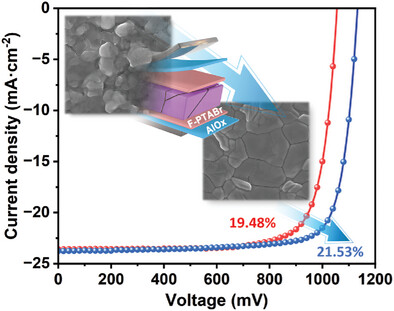
A dual modification approach involving AlOx and F-doped phenyltrimethylammonium bromide (F-PTABr) layers is employed to improve the buried interface contact and perovskite crystallization process during vapor–solid reaction. As a result, perovskite solar cells exhibit a impressive improvement in power conversion efficiency from 19.48% of the reference device to 21.53% of the modified devices.
Photodual-Responsive Anthracene-Based 2D Covalent Organic Framework for Optoelectronic Synaptic Devices
- First Published: 31 October 2024
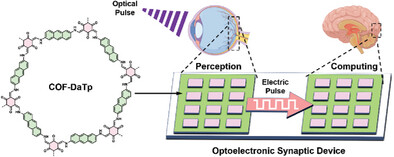
An anthracene-based 2D covalent organic framework (COF-DaTp), exhibiting photodual-responsive properties, is synthesized via a room-temperature interface-confined strategy. The constructed Al/COF-DaTp/ITO optoelectronic synaptic device is capable of simultaneously performing optical sensing and executing basic tasks in image denoising and recognition. This integration significantly enhances recognition accuracy and decreases the number of training epochs compared to datasets without noise mitigation.
High-Performance Perovskite Flat Panel X-Ray Imagers via Blade Coating
- First Published: 10 December 2024
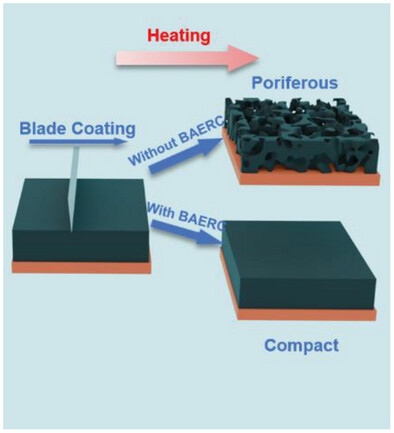
This study develops a precursor paste suitable for blade coating to directly deposit hundreds-micrometer-thick dense perovskite films onto pixeled thin-film transistor (TFT) backplane, achieving facile fabrication of flat panel X-ray imagers. The X-ray imager achieves a spatial resolution of 0.95 lp mm−1 (0.475 lp pixel−1), which exhibits excellent X-ray imaging performance.
The Direct Air Synthesis of Hydrogen Peroxide Induced by The Giant Built-In Electric Field of Trz-CN
- First Published: 14 February 2025
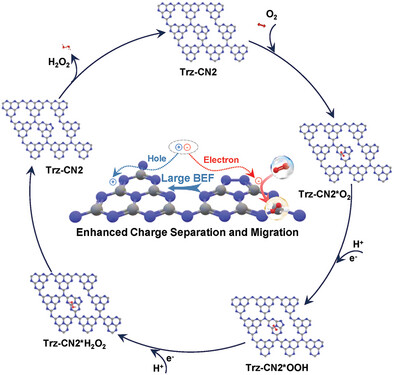
A carbon nitride (Trz-CN) synthesized through a hydrothermal-calcination tandem strategy has been reported. Trz-CN features a substantial built-in electric field that effectively promotes the efficient separation and directional migration of photogenerated carriers. Furthermore, when air is utilized as feedstock instead of oxygen, Trz-CN achieves a comparable production of hydrogen peroxide.
A Versatile Method for Preparation of BrCOFs Aerogels and Efficient Functionalization via Suzuki–Miyaura Reaction
- First Published: 10 November 2024
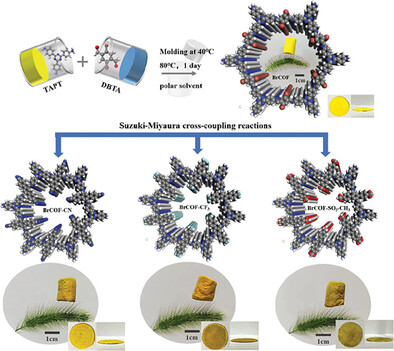
BrCOFs aerogels are synthesized without vacuum by seven kind polar solvents, which displays a general preparation method. And, by Suzuki-Miyaura cross-coupling reaction, the BrCOFs aerogels are endows groups with cyano (-CN), trifluoromethyl (-CF3), and methyl sulfonyl (-SO2-CH3) efficiently, which are more conducive to targeted functional application enhancement.
Homogeneous Integration of Polyoxometalates and Titania into Crumpled Layers
- First Published: 18 October 2024

Uniform, crumpled 2D nanosheets are rationally designed through the co-assembly of structurally unique polyoxometalates and titania. Palladium nanoclusters are supported on these nanosheets, which are used as heterogeneous catalysts for acetylene partial hydrogenation, achieving ≈100% selectivity and yield, surpassing commercial titania catalysts. This research can lead to the design of new materials with enhanced catalytic properties.
Ultralow-Power Programmable 3D Vertical Phase-Change Memory with Heater-All-Around Configuration
- First Published: 05 November 2024

Ultralow-power programmable 3D vertical phase-change memory devices are demonstrated. The proposed heater-all-around device configuration with 3D Joule heater enables ultra-low operational current through highly localized electro-thermal heating. Its reliable nonvolatile memory performance and multi-bit per cell operation highlight the potential of the cell architecture as a universal phase-change memory device backbone.
Photoswitchable Gold Nanoparticles for Super-Resolution Radial Fluctuation Imaging in Nanostructured Materials
- First Published: 29 December 2024
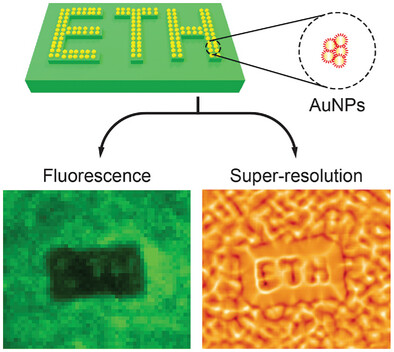
Gold nanoparticles are demonstrated as a promising alternative to traditional fluorescent probes in super-resolution imaging. Their unique photoluminescence and blinking behavior enable imaging of nanoscale structures, with resolutions down to 100 nm. This method overcomes challenges such as photobleaching, making gold nanoparticles suitable for imaging in non-liquid environments, and advancing super-resolution fluorescence microscopy in materials science.
Graphene Oxide/Zinc Phthalocyanine Selective Singlet Oxygen Visible-Light Nanosensor for Raman-Inactive Compounds
- First Published: 20 December 2024
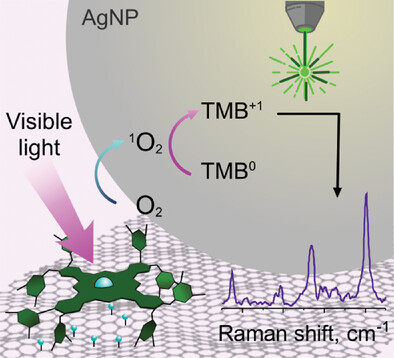
A hybrid nanofilm assembled via ion-mediated surface anchoring of functionalized zinc phthalocyanine onto graphene oxide monolayer selectively generates 1O2 under visible light. The hybrid is used for ultrafast SERS sensing of Raman-inactive compound through its direct single-electron oxidation into detectable molecular form. This SERS platform can significantly expand the range of Raman-detectable substances through rapid and technically simple screening.
Group IV Bimetallic MOFs Engineering Enhanced Metabolic Profiles Co-Predict Liposarcoma Recognition and Classification
- First Published: 06 January 2025

In terms of metal node valence and composition, Group IV bimetallic MOFs engineering series materials have comparative advantages as MALDI matrices for metabolic analysis. Ti/Zr-based MOFs and their derivatives with excellent thermal stability and energy/charge transfer ability allow metabolites to be desorbed and ionized efficiently in complex biofluids. The platform based on TZO-assisted MALDI MS interacts with machine learning to construct efficient LPS recognizers and classifiers for accurate diagnosis and typing of LPS, with an AUC of 0.850–1000.
Facile Growth of h-BN Films by Using Surface-Activated h-BN Powders as Precursors
- First Published: 14 February 2025
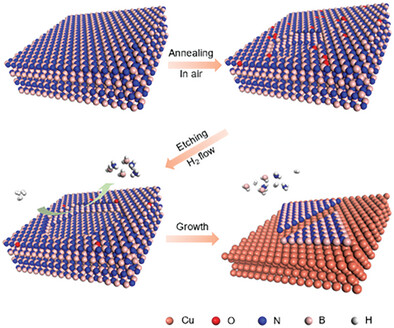
Using surface-activated h-BN powders as precursors can realize the effective and green growth of high-quality h-BN film by chemical vapor deposition method. Combined with experimental results and molecular dynamics simulations, the activation mechanism of h-BN powders is revealed that unstable BO3 and O-terminal edges on the surface of As-hBN will decompose to form B-H active species under H2.
Electrochemical Exfoliation of Large Antioxidative MXene Flakes for Polymeric Fire Safety
- First Published: 21 November 2024
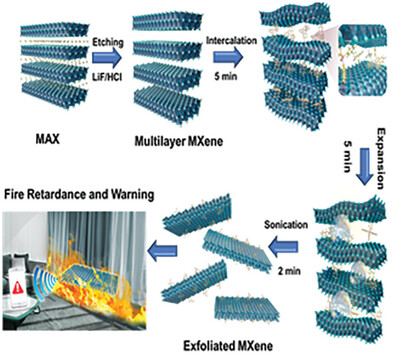
An electrochemical exfoliation approach is proposed to achieve a high recording yield of 87% for preparing large antioxidative MXene flakes with an average lateral size of 8.3 µm, which combines the etching, electrolyte intercalation, interlay expansion and short-time sonication. The MXene flakes can improve polymeric fire safety, including flame retardance and fire warning.
From Optical Fiber Communications to Bioimaging: Wavelength Division Multiplexing Technology for Simplified in vivo Large-depth NIR-IIb Fluorescence Confocal Microscopy
- First Published: 07 November 2024
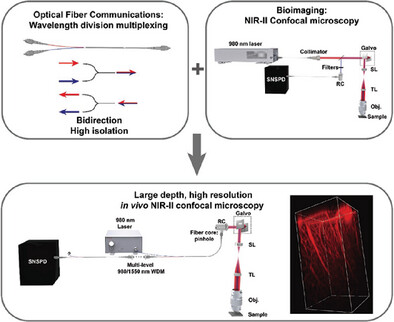
A fiber optical wavelength division multiplexing (WDM) replaces dichroic mirror and pinhole in traditional spatial confocal microscopy, coupling Near-infrared II (NIR-II, 900-1880 nm) fluorescence and excitation light into one single-mode fiber, simplifying the system and reducing adjustment difficulty. This setup achieves large-depth, high-resolution in vivo NIR-II confocal imaging of mouse brain vessels and liver vessels.
A Long-Life Zinc-Bromine Single-Flow Battery Utilizing Trimethylsulfoxonium Bromide as Complexing Agent
- First Published: 03 February 2025
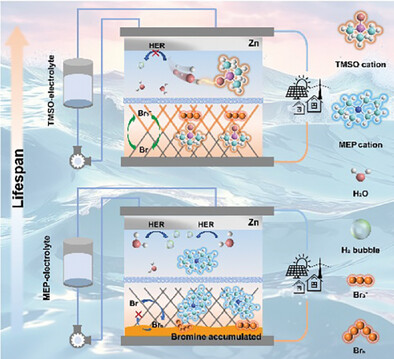
The limited operational lifespan of zinc-bromine single-flow batteries (ZBSFBs) poses a significant barrier to their large-scale commercial viability. Trimethylsulfoxonium bromide, a novel complexing agent, is introduced to mitigate the bromine accumulation by alleviating hydrogen evolution reaction and decreasing polarization, thereby effectively extending the cycle life of ZBSFBs.
Boosting FRET Efficiency of Chromophores with Aggregation-Caused Quenching by a Crystallization-Induced Precise Co-assembly Strategy
- First Published: 30 October 2024
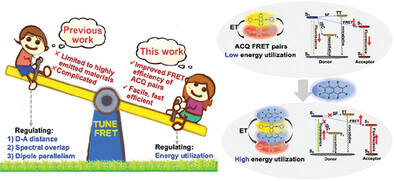
A subtly and powerful strategy, i.e., crystallization-induced precise co-assembly (CIPCA) involving a “lightening agent,” is developed to effectively improve the FRET efficiency of ACQ pairs. The monotonous and weak emission for FRET BPA@BPN can be regulated to colorful and much brighter ones with FRET efficiency improvement of as high as 180–270%, which allows to fabricate distinct multi-stimuli-responsive fluorescent patterns.
Probing Photo-Assisted Charge Storage Mechanism Using Bi-Fe Perovskite Oxide Electrode for Solar Supercapacitor
- First Published: 23 December 2024

Hybridized states of Fe(3d) and O(2p) orbitals and hetero-valent states of Bi and Fe induced electrochemical contributions in BiFeO3 electrodes of solar supercapacitor, leading to enhanced charge transfer and hence the improved specific capacity of 21 Cg−1 at 2 Ag−1 and 77.5% retention after 1000 continuous GCD cycles under visible light irradiation.
Coupling CoIr Nanoalloys with MXene by Lewis Acidic Molten Salt Etching for Wide-pH-Environment Hydrogen Evolution Reaction
- First Published: 27 October 2024
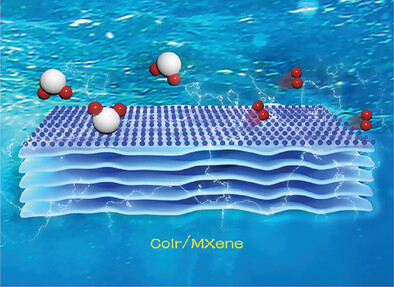
The Alloys/MXene catalyst prepared by a Lewis acidic molten salt etching strategy possesses strong metal support interaction and hydrophilic interfaces, which contribute to interfacial charge distribution, fast electron transfer, and adsorption of H2O, thereby exhibiting rapid hydrogen evolution reaction kinetics in wide pH range.
Versatile and Fast Electrochemical Activation Method for Carbon Nanotube Fibers with Diverse Active Materials
- First Published: 17 December 2024
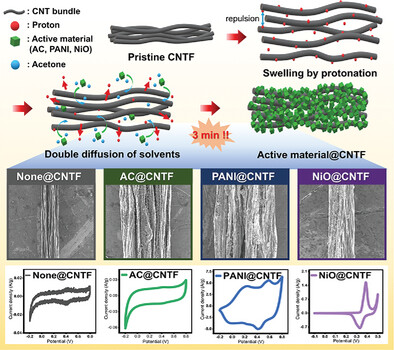
To address the limited electrochemical capability of carbon nanotube fibers (CNTFs), the study introduces a rapid and versatile modified chlorosulfonic acid densification process. This technique enables the efficient integration of diverse active materials, including conductive polymers and metal oxides, into CNTFs, significantly improving their physical and electrochemical characteristics within minutes. This streamlined approach holds substantial potential for advancing fiber-shaped energy storage devices.
Smart Compositional Design of B-Site Ordered Double Perovskite for Advanced Oxygen Catalysis at Ultra-High Current Densities
- First Published: 17 December 2024
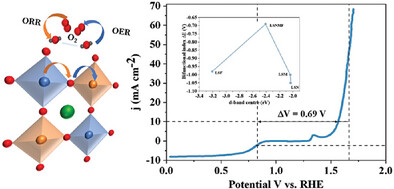
Ingenious B-site ordered La1.5Sr0.5NiMn0.5Fe0.5O6 (LSNMF) double perovskite is strategically designed by simultaneously interposing Ni0.5Mn0.5 and Ni0.5Fe0.5 into B′ and B″ sites. Controlling B-site cation tailors the electronic structure with a d-band center (Md) close to the Fermi level, increasing the overlap of Md and O2p center (OP). The strong interaction of Md and Op facilitates the adsorption of oxygen and activates the lattice oxygen to participate in the Oevolution reaction, thereby enhancing bifunctional activity. LSNMF is efficient and lucrative for practical application.
Colorimetric Fabry-Pérot Sensor with Hetero-Structured Dielectric for Humidity Monitoring
- First Published: 31 October 2024
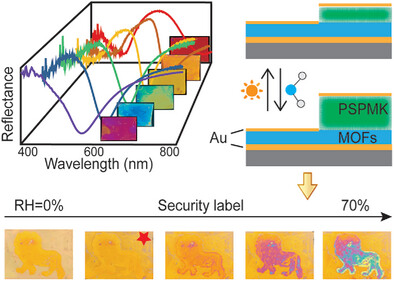
A metal-insulator-metal resonator with high color saturation is constructed by sandwiching hetero-structured ZIF-8-PSPMK dielectric layer between Au layers. Reflected band of the resonator is modulated by optimizing the polymer thickness. The hetero-structured MIM resonator demonstrates vivid full-color tuning and ultrafast response for humidity sensing. 2D design of multiplexing imaging of the resonator demonstrates the function of security labeling for anti-counterfeits.
Tuning Electronic and Functional Properties in Defected MoS2 Films by Surface Patterning of Sulphur Atomic Vacancies
- First Published: 12 November 2024
Electrochemiluminescence Reveals the Structure-Catalytic Activity Relationship of Heteroatom-Doped Carbon-Based Materials
- First Published: 29 October 2024

Reactive oxygen species (ROS)-triggered electrochemiluminescence (ECL) is used to investigate the catalytic mechanism of heteroatom-doped carbon-based materials (N-C and NP-C). P, N-doped NP-C facilitates the activation of H2O2 and exhibits superior catalytic ability for activating H2O2 to generate a large amount of •OH and O2•−, compared with N-C, as evidenced by the significantly enhanced ECL emission.
Sn Penetrated Zincophilic Interface Design in Porous Zn Substrate for High Performance Zn-Ion Battery
- First Published: 07 November 2024
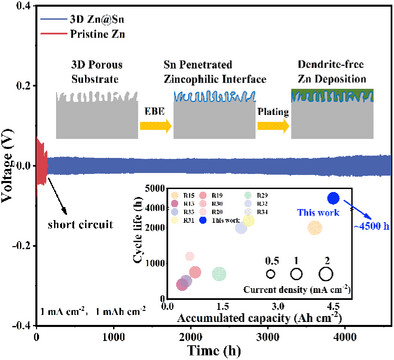
Through handy etching and efficient electron beam evaporation strategies, a modified host-design with a 3D porous Zn and Sn penetrated interface endows Zn anode with a steady and prolonged galvanostatic cycle performance (≈4500 h) in the symmetric cell, which is much higher than that of the similar works, and provides a new idea for the preparation of high-performance zinc anode.
Light-to-Spike Encoding Using Indium-Gallium-Zinc Oxide Phototransistor for all-Color Image Recognition with Dynamic Range and Precision Tunability
- First Published: 08 December 2024

Inspired by human visual system, this work utilizes an IGZO phototransistor to sense RGB light densities. By applying stochastic VG pulses to the IGZO phototransistor, the device encodes light signals into spike rates, combining sensing and encoding. With separate RGB channels, the modulation becomes more flexible in color information encoding. This approach enhances the performance and applicability of optoelectronic neuromorphic systems.
Ultrahigh-Selectivity Photocatalytic Upgrading of Bio-Aldehydes/Diols to Monoalcohols Via In Situ Circumventing Coupling Co-Products Over Janus Single-Atom Pd/TiO2
- First Published: 15 January 2025
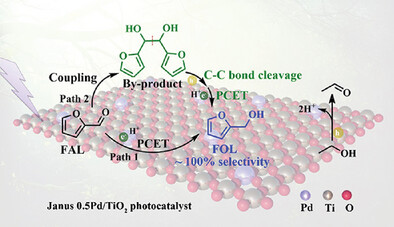
Photocatalytic transfer hydrogenation of furfural (FAL) enabled by in situ conversion of coupling by-product via relay C─C bond cleavage and proton-coupled electron transfer (PCET) can exclusively furnish furfuryl alcohol (FOL) with ultrahigh selectivity (ca. 100%) over a Janus single-atom 0.5Pd/TiO2 catalyst in ethanol at 25 °C.
TVT-Based New Building Block with Enhanced π-Electron Delocalization for Efficient Non-Fused Photovoltaic Acceptor
- First Published: 09 November 2024
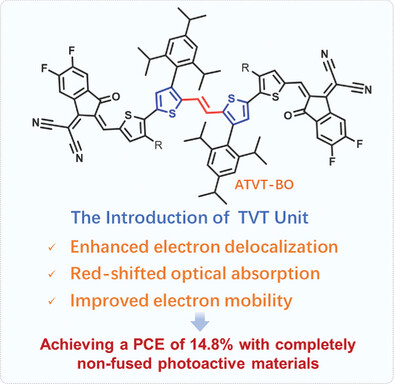
Innovative design of the low-cost small molecule acceptor ATVT-BO, utilizing the TVT unit as its central core, markedly enhances molecular planarity while reducing aromaticity. This optimization leads to improved electron mobility and a red-shift in optical absorption. When combined with the TVT unit-based polymer donor PTVT-T, the resulting PTVT-T:ATVT-BO-based device achieves a remarkable PCE of 14.8%.
CrS Doped MOF-Derived Carbon Implanted CoNi Particles as Exceedingly Effectual Oxygen Electrocatalysts in Sustainable Zinc-Air Batteries
- First Published: 21 February 2025
Enhanced Electrochemical Performance of Polyaniline-Boron Doped Diamond Electrode for Supercapacitor Applications
- First Published: 05 January 2025
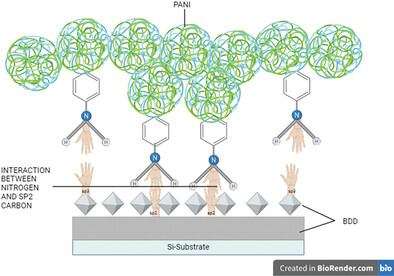
The synergy between appropriate boron doping nanodiamond support and optimized PANI suspension is studied. The interaction and performance of the composite electrodes depend on the crystal size, electrical resistivity, and sp2 carbon content of the support and reaction polymerization of PANI suspension. The composite electrode exhibits the highest specific capacitance of 958 F g−1, representing 90% of the theoretical capacitance.
Heterogeneity During the Formation of Waterborne Barrier Coating Revealed by Cryogenic Transmission Electron Microscopy
- First Published: 23 December 2024
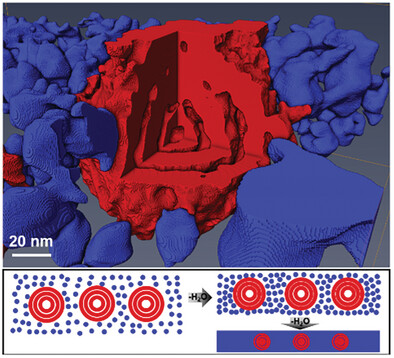
This work has unveiled the formation process of waterborne barrier coating from poly(ethylene-co-methacrylic acid) particle dispersions using state-of-the-art cryogenic transmission electron microscopy and tomography. Onion-like nanoaggregates that are harmful to the coating performance are observed during the process, which can be removed by tuning the interaction between the particles. The study is beneficial for the development of waterborne coating materials.
Tuning the Sensitivity of MoS2 Nanopores: From Labeling to Labeling-Free Detection of DNA Methylation
- First Published: 18 November 2024
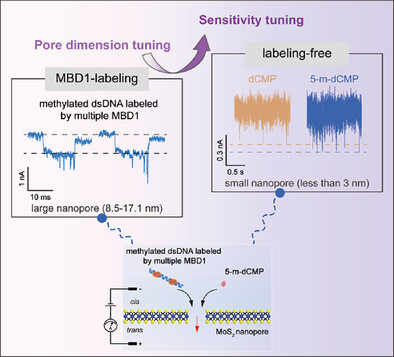
This work develops engineered MoS2 nanopores with tunable sensitivity for DNA methylation discrimination. Through tuning pore dimension, the sensitivity of MoS2 devices can be manipulated, which empowers labeling and labeling-free single-molecule readout of DNA methylation. This study illustrates the structural and functional tunability of MoS2 nanopores in DNA methylation detection, underscoring their potential for epigenetic alteration research.
Molecular Design of Positively Charged 3D Covalent−Organic Framework Membranes for Li+/Mg2+ Separation
- First Published: 31 December 2024
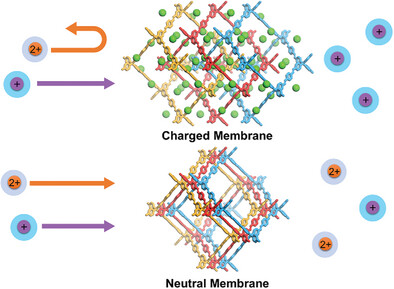
A series of 3D-COF membranes with different charge densities and interpenetration numbers are designed. Molecular simulation reveals that the pore size and Cl− ion density play a crucial role in governing membrane separation performance. 3D-COF membrane with a smaller interpenetration number and a higher charge density promotes Li+/Mg2+ separation.
Deciphering Spatially-Resolved Electrochemical Nucleation and Growth Kinetics by Correlative Multimicroscopy
- First Published: 20 November 2024

By integrating Scanning Electrochemical Cell Microscopy (SECCM) and Field Emission Scanning Electron Microscopy (FESEM), provide new insights into electrochemical nucleation and growth (EN&G). This approach enables surface characterization of electrochemically interrogated areas at identical locations and scales. By adapting an EN&G model to SECCM geometry, we study active sites locally, revealing how surface heterogeneity influences nucleation across regions with varying activity.
Employing a Zn-air/Photo-Electrochemical Cell for In Situ Generation of H2O2 for Onsite Control of Pollutants
- First Published: 19 January 2025
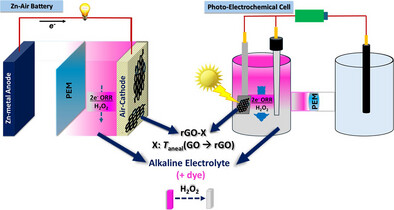
A dual-functional approach for sustainable hydrogen peroxide (H2O2) production and pollutant degradation is demonstrated in Zn-air and photoelectrochemical cells employing a reduced graphene oxide (rGO) electrocatalyst. Achieving a power density of 320 W m_geo−2 (geo-geometric area) and a H2O2 production rate of 3.17 mol m_geo−2 h−1, the system utilizes reactive oxygen species for efficient rhodamine B degradation, enhanced under visible light illumination.
FeOOH Quantum Dots Assembled MXene-Decorated 3D Photothermal Evaporator for Synergy Application in Solar Evaporation and Fenton Degradation
- First Published: 10 November 2024
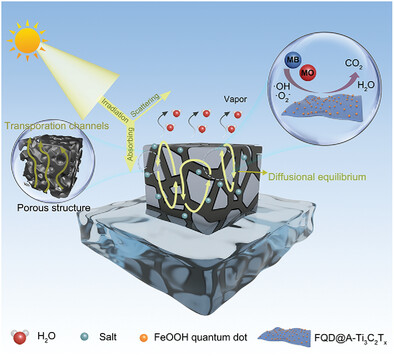
Multifunctional sponge-based solar evaporator combines with photothermal and photocatalytic performance of FeOOH quantum dots assembled MXene composites and the superhydrophilicity of chitosan hydrogel coating. The resulting solar evaporator possesses high performance in solar evaporation with evaporation rate over 2.54 kg m−2 h−1 and durable salt-resistance, coupling with high efficiency photo-Fenton degradation capability for MB (99.24%) and MO (95.33%).
A Boat-Paddle-Like Molecule Binder with Twining-Blocked and Ultrafast Self-Healing Functionalities for Stable Silicon Anodes
- First Published: 25 November 2024
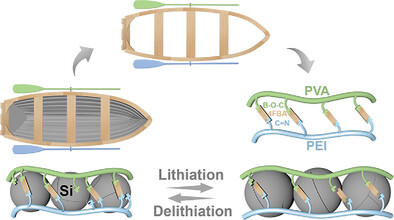
Inspired by the boat-paddle model, the parallel paddles-like polymer chains (PVA and PEI) planning reversibly dictated by a boat-like monomer (4FBA) blocking twining via dual junctions (C═N and B─O─C) breakage and reunion, integrating superior mechanical properties of each chain, the composite molecule compatibly achieves ultrafast self-healing of merely 2 min and stable mechano-chemistry among state-of-the-art self-healing binder materials.
Bacteria Flagella-Mimicking Polymer Multilayer Magnetic Microrobots
- First Published: 21 January 2025
Tailoring the Interfacial Composition of Heterostructure InP Quantum Dots for Efficient Electroluminescent Devices
- First Published: 15 December 2024
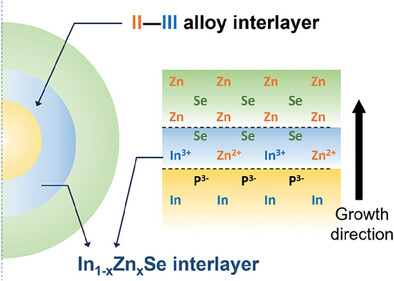
The effect of interfacial stoichiometry on the optical and electrical properties of InP core–shell quantum dots (QDs) is investigated. Directly injected Se ions formed a thin InZnSe alloy layer, which reduces the misfit between the InP core and ZnSe shell. Especially, the InZnSe interlayer improves the charge injection efficiency and mitigates charge imbalance in EL application.
Redesign of Translocon EXP2 Nanopore for Detecting Peptide Fragments
- First Published: 05 February 2025
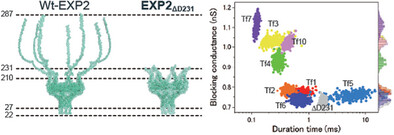
Nanopore sensing using the EXP2 nanopore from Plasmodium falciparum is enhanced by engineering mutants to reduce electrical noise and improve peptide detection. The EXP2ΔD231 mutant showed over 50% noise reduction and successfully discriminated diverse peptides, highlighting its potential for protein sequencing. This advancement broadens nanopore technology's applications in biochemical and clinical research.
Engineering MXene Surface via Oxygen Functionalization and Au Nanoparticle Deposition for Enhanced Electrocatalytic Hydrogen Evolution Reaction
- First Published: 12 November 2024
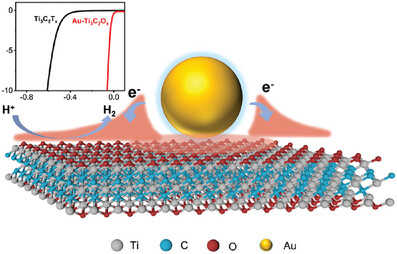
The Au-Ti3C2Ox catalyst, where Au nanoparticles are deposited on oxygen-functionalized Ti3C2Tx MXene, demonstrates significantly enhanced efficiency in hydrogen evolution reaction. The -O functional groups act as active sites and modify the surface potential, directing electron transfer from Au NPs to MXene due to electronic metal-support interaction, leading to enhanced catalytic activity of the MXene surface with a larger surface area.
In Silico Detection and Conveyance Feasibility of Antifungal Prodrug Flucytosine on the Surface of Pristine and Germanium-Doped SiC Nanosheet
- First Published: 26 December 2024
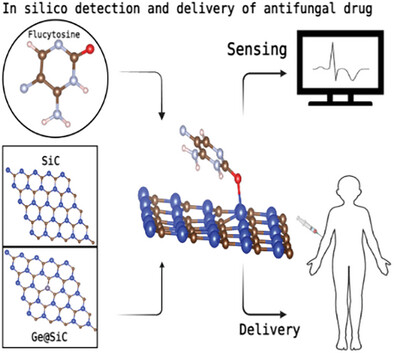
The present study explores the role of 2-D SiC and Ge-doped SiC in sensing of antifungal drug Flucytosine (5-FC) using the DFT framework. Adsorption energy, electronic property calculation, sensing parameters, and recovery time analysis assess the sensing potential and the desorption feasibility. The work paves way for guiding future experiments on 5-FC sensing/delivery using nanomaterials.
Self-healing Micro-Supercapacitor Based on Robust Liquid Metal-CNT-PEDOT:PSS Film for Wireless Powering of Integrated Strain Sensor
- First Published: 08 December 2024
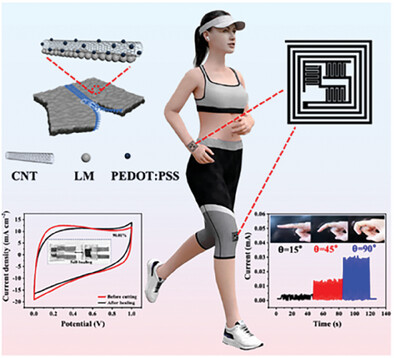
A robust and wrinkled liquid metal-CNT-PEDOT:PSS film with high capacity and self-healing properties(defined as LM-CNT-PEDOT:PSS) is produced by pre-stretching strategies, LM-CNT-PEDOT:PSS micro-supercapacitor unit can be arbitrarily integrated according to various energy and voltage requirements, and the sensor prepared by the LM-CNT-PEDOT:PSS film has excellent sensing performance and can be integrated with wireless charging to easily monitor physiological signals.





